
Originally appeared here:
Ground truth curation and metric interpretation best practices for evaluating generative AI question answering using FMEval


Originally appeared here:
Ground truth curation and metric interpretation best practices for evaluating generative AI question answering using FMEval


Understanding ratios is key to unlocking deeper insights into your business’s health and driving smarter decision-making
Originally appeared here:
Why Ratios Trump Raw Numbers in Business Health
Go Here to Read this Fast! Why Ratios Trump Raw Numbers in Business Health

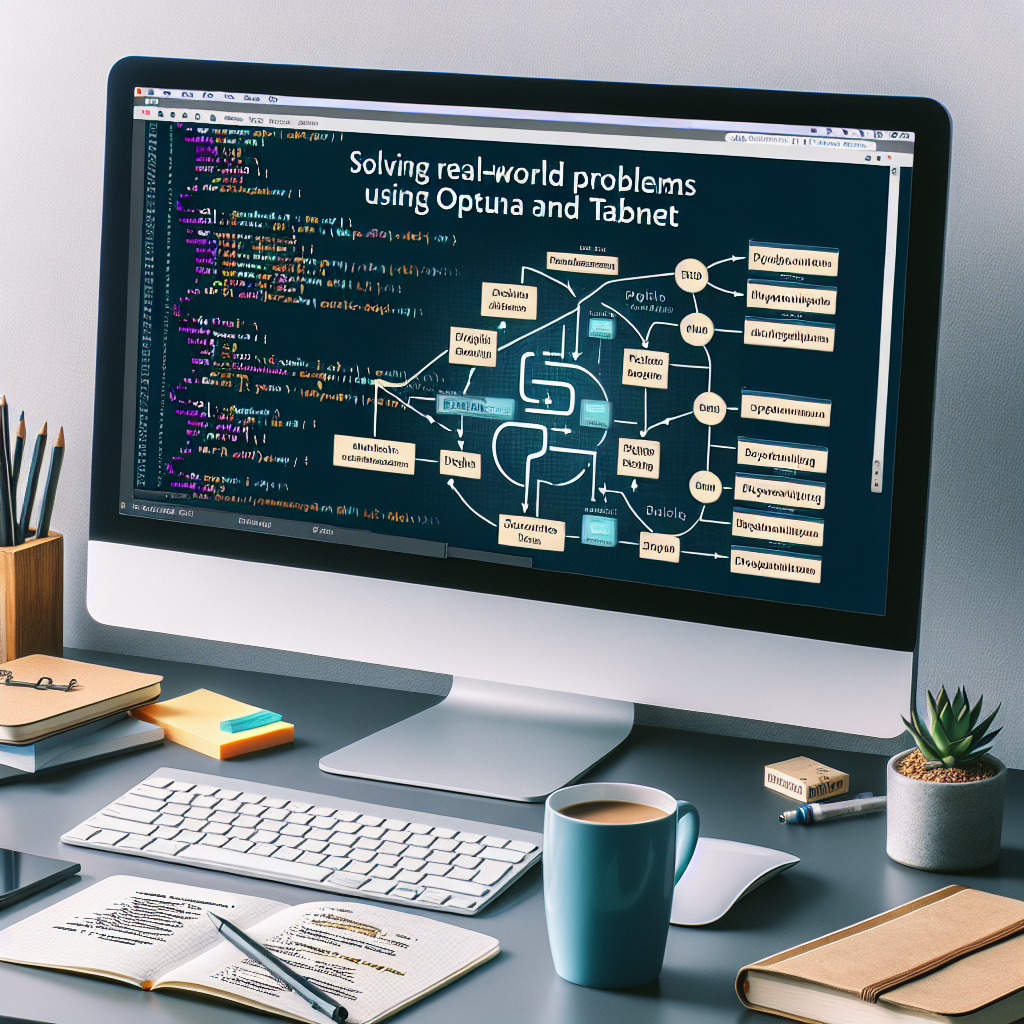

During my years working as a Data Scientist, I have met a lot of students interested in becoming one themselves, or newly graduated just starting out. Starting a career in data science, like any field, involves a steep learning curve.
One, very good, question that I keep getting is: I have learned a lot about the theoretical aspects of data science, but what does a real world example look like?
I want to share small pieces of work, from different projects I have been working on throughout my career. Even though some might be a few years old, I will only write about subjects which I still find relevant. I will try to keep the overarching picture clear and concise, so that new aspiring colleagues will get a grasp of what might be coming up. But I also want to stop and look into details, which I hope that more experienced developers might get some insights out of.
Business Case
Let’s now delve into the specific business case that drove this initiative. The team included a project manager, client stakeholders, and myself. The client needed a way to forecast the usage of a specific service. The reason behind this was resource allocation for maintaining the service and dynamic pricing. Experience with behaviour about the service usage was mostly kept within skilled coworkers, and this application was a way to be more resilient towards them retiring together with their knowledge. Also, the onboarding process of new hirings was thought to be easier with this kind of tool at hand.
Data and Analytical Setup
The data had a lot of features, both categorical and numerical. For the use case, there was a need to forecast the usage with a dynamical horizon, i.e. a need to make predictions for different periods of time into the future. There were also many, correlated and uncorrelated, values needed to be forecasted.
These multivariate time series made the attention mostly focused on experimenting with time series based models. But ultimately, Tabnet was adopted, a model that processes data as tabular.
There are several interesting features in the Tabnet architecture. This article will not delve into model details. But for the theoretical background I recommend doing some research. If you don’t find any good resources, I find this article a good overview or this paper for a more in depth exploration.
As a hyper parameter tuning framework, Optuna was used. There are also other frameworks in Python to use, but I have yet to find a reason not to use Optuna. Optuna was used as a Bayesian hyperparameter tuning, saved to disk. Other features utilized are early stopping and warm starting. Early stopping is used for resource saving purposes, not letting non promising looking trials run for too long. Warm starting is the ability to start from previous trials. This I find useful when new data arrives, and not having to start the tuning from scratch.
The initial parameter widths, will be set as recommended in the Tabnet documentation or from the parameter ranges discussed in the Tabnet paper.
To convey for the heteroscedastic nature of the residuals, Tabnet was implemented as a quantile regression model. To do this, or for implementing any model in this fashion, the pinball loss function, with suitable upper and lower quantiles, was used. This loss function has a skewed loss function, punishing errors unequally depending if they are positive or negative.
Walkthrough with Code
The requirements used for these snippets are as follows.
pytorch-tabnet==4.1.0
optuna==3.6.1
pandas==2.1.4
Code for defining the model.
import os
from pytorch_tabnet.tab_model import TabNetRegressor
import pandas as pd
import numpy as np
from utils import CostumPinballLoss
class mediumTabnetModel:
def __init__(self,
model_file_name,
dependent_variables=None,
independent_variables=None,
batch_size=16_000,
n_a=8,
n_steps=3,
n_independent=2,
n_shared=2,
cat_idxs=[],
cat_dims=[],
quantile=None):
self.model_file_name = model_file_name
self.quantile = quantile
self.clf = TabNetRegressor(n_d=n_a,
n_a=n_a,
cat_idxs=cat_idxs,
cat_dims=cat_dims,
n_steps=n_steps,
n_independent=n_independent,
n_shared=n_shared)
self.batch_size = batch_size
self.independent_variables = independent_variables
self.dependent_variables = dependent_variables
self.cat_idxs = cat_idxs # Indexes for categorical values.
self.cat_dims = cat_dims # Dimensions for categorical values.
self.ram_data = None
def fit(self, training_dir, train_date_split):
if self.ram_data is None:
data_path = os.path.join(training_dir, self.training_data_file)
df = pd.read_parquet(data_path)
df_train = df[df['dates'] < train_date_split]
df_val = df[df['dates'] >= train_date_split]
x_train = df_train[self.independent_variables].values.astype(np.int16)
y_train = df_train[self.dependent_variables].values.astype(np.int32)
x_valid = df_val[self.independent_variables].values.astype(np.int16)
y_valid = df_val[self.dependent_variables].values.astype(np.int32)
self.ram_data = {'x_train': x_train,
'y_train': y_train,
'x_val': x_valid,
'y_val': y_valid}
self.clf.fit(self.ram_data['x_train'],
self.ram_data['y_train'],
eval_set=[(self.ram_data['x_val'],
self.ram_data['y_val'])],
batch_size=self.batch_size,
drop_last=True,
loss_fn=CostumPinballLoss(quantile=self.quantile),
eval_metric=[CostumPinballLoss(quantile=self.quantile)],
patience=3)
feat_score = dict(zip(self.independent_variables, self.clf.feature_importances_))
feat_score = dict(sorted(feat_score.items(), key=lambda item: item[1]))
self.feature_importances_dict = feat_score
# Dict of feature importance and importance score, ordered.
As a data manipulation framework, Pandas was used. I would also recommend using Polars, as a more efficient framework.
The Tabnet implementation comes with a pre-built local and global feature importance attribute to the fitted model. The inner workings on this can be studied in the article posted previous, but as the business use case goes this serves two purposes:
together with the subject matter experts. In the end application, the interpretability was included to be displayed to the user. Due to data anonymization, there will not be a deep dive into interpretability in this article, but rather save it for a case where the true features going into the model can be discussed and displayed.
Code for the fitting and searching steps.
import optuna
import numpy as np
def define_model(trial):
n_shared = trial.suggest_int('n_shared', 1, 7)
logging.info(f'n_shared: {n_shared}')
n_independent = trial.suggest_int('n_independent', 1, 16)
logging.info(f'n_independent: {n_independent}')
n_steps = trial.suggest_int('n_steps', 2, 8)
logging.info(f'n_steps: {n_steps}')
n_a = trial.suggest_int('n_a', 4, 32)
logging.info(f'n_a: {n_a}')
batch_size = trial.suggest_int('batch_size', 256, 18000)
logging.info(f'batch_size: {batch_size}')
clf = mediumTabnetModel(model_file_name=model_file_name,
dependent_variables=y_ls,
independent_variables=x_ls,
n_a=n_a,
cat_idxs=cat_idxs,
cat_dims=cat_dims,
n_steps=n_steps,
n_independent=n_independent,
n_shared=n_shared,
batch_size=batch_size,
training_data_file=training_data_file)
return clf
def objective(trial):
clf = define_model(trial)
clf.fit(os.path.join(args.training_data_directory, args.dataset),
df[int(len(df) * split_test)])
y_pred = clf.predict(predict_data)
y_true = np.array(predict_data[y_ls].values).astype(np.int32)
metric_value = call_metrics(y_true, y_pred)
return metric_value
study = optuna.create_study(direction='minimize',
storage='sqlite:///db.sqlite3',
study_name=model_name,
load_if_exists=True)
study.optimize(objective,
n_trials=50)
The data are being split into a training, validation and testing set. The usage for the different datasets are:
One final note is that to mimic the behavior of when the model is deployed, as much as possible, the datasets is being split on time. This means that the data from the first 80% of the period goes into the training part, the next 10% goes into validation and the most recent 10% into testing.

For the example presented here, the trials are saved to disk. A more common approach is to save it to a cloud storage for better accessibility and easier maintenance. Optuna also comes with a UI for visualization, which can be spin up running the following command in the terminal.
pip install optuna-dashboard
cd /path/to/directory_with-db.sqlite3/
optuna-dashboard sqlite:///db.sqlite3
A manual task for sanity checking the parameter tuning, is to see how close to the sampling limits, the optimal parameters are. If they are reasonably far away from the bounds set, there is no need to look further into broadening the search space.
An in-depth look into what is displayed from the tuning can be found here.
And here is a visualisation of some of the results.



Conclusions and client remarks.
The graph indicates increased uncertainty when forecasting service usage further into the future. This is to be expected, also confirmed by the client.
As noticed, the model is having difficulties finding the spikes that are out of the ordinary. In the real use case, the effort was focused on looking into more sources of data, to see if the model could better predict these outliers.
In the final product there was also introduced a novelty score for the data point predicted, using the library Deepchecks. This came out of discussions with the client, trying to detect data drift and also for user insights into the data. In another article, there will be a deep dive on how this could be developed.
Thank you for reading!
I hope you found this article useful and/or inspiring. If you have any comments or question, please reach out! You can also connect with me on LinkedIn.
Real world Use Cases: Forecasting Service Utilization Using Tabnet and Optuna was originally published in Towards Data Science on Medium, where people are continuing the conversation by highlighting and responding to this story.
Originally appeared here:
Real world Use Cases: Forecasting Service Utilization Using Tabnet and Optuna

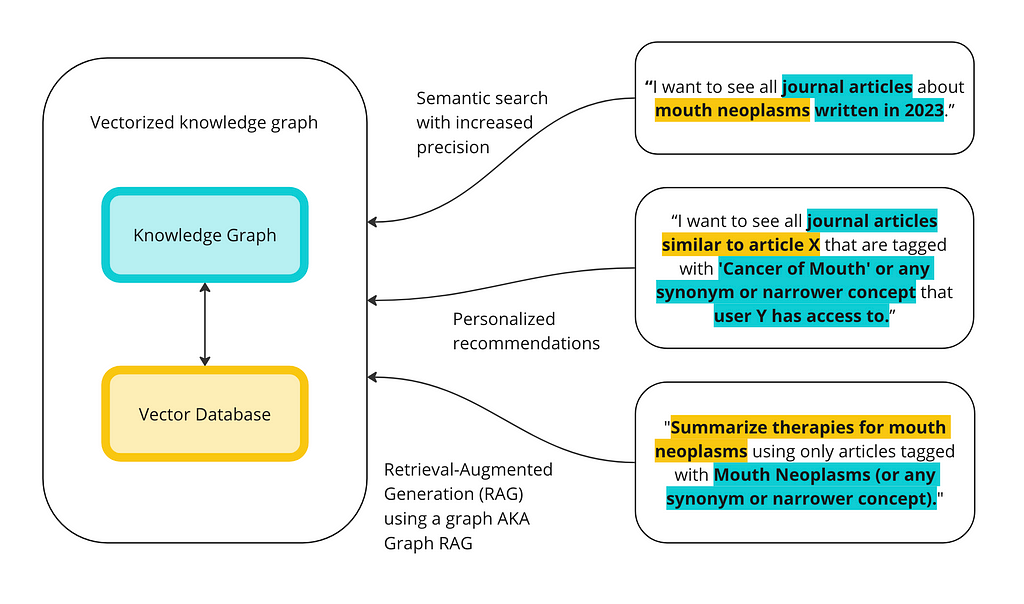

The accompanying code for this tutorial is here.
My last blog post was about how to implement knowledge graphs (KGs) and Large Language Models (LLMs) together at the enterprise level. In that post, I went through the two ways KGs and LLMs are interacting right now: LLMs as tools to build KGs; and KGs as inputs into LLM or GenAI applications. The diagram below shows the two sides of integrations and the different ways people are using them together.
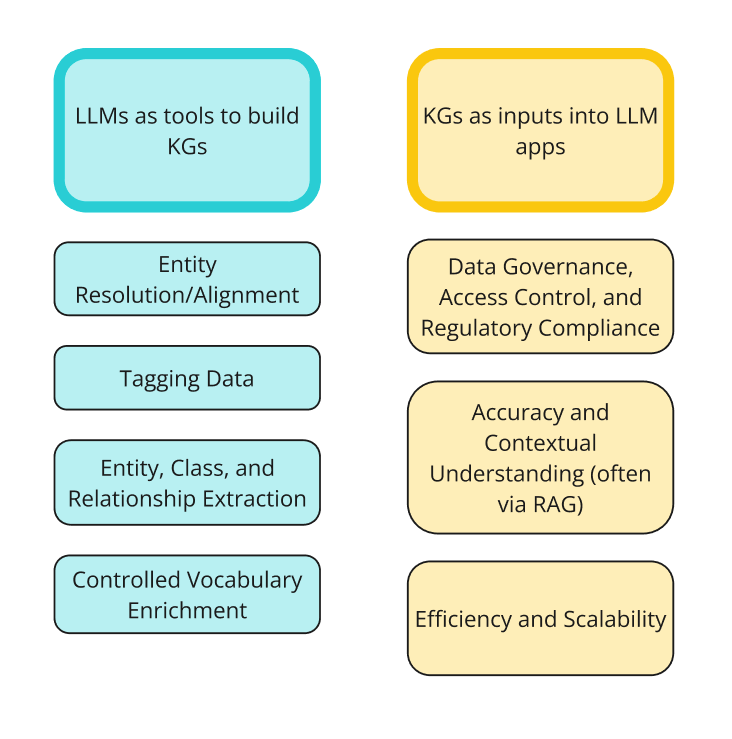
In this post, I will focus on one popular way KGs and LLMs are being used together: RAG using a knowledge graph, sometimes called Graph RAG, GraphRAG, GRAG, or Semantic RAG. Retrieval-Augmented Generation (RAG) is about retrieving relevant information to augment a prompt that is sent to an LLM, which generates a response. The idea is that, rather than sending your prompt directly to an LLM, which was not trained on your data, you can supplement your prompt with the relevant information needed for the LLM to answer your prompt accurately. The example I used in my previous post is copying a job description and my resume into ChatGPT to write a cover letter. The LLM is able to provide a much more relevant response to my prompt, ‘write me a cover letter,’ if I give it my resume and the description of the job I am applying for. Since knowledge graphs are built to store knowledge, they are a perfect way to store internal data and supplement LLM prompts with additional context, improving the accuracy and contextual understanding of the responses.
What is important, and I think often misunderstood, is that RAG and RAG using a KG (Graph RAG) are methodologies for combining technologies, not a product or technology themselves. No one invented, owns, or has a monopoly on Graph RAG. Most people can see the potential that these two technologies have when combined, however, and there are more and more studies proving the benefits of combining them.
Generally, there are three ways of using a KG for the retrieval part of RAG:
There are, however, many ways of combining vector databases and KGs for search, similarity, and RAG. This is just an illustrative example to highlight the pros and cons of each individually and the benefits of using them together. The way I am using them together here — vectorization for initial retrieval and then SPARQL for filtering — is not unique. I have seen this implemented elsewhere. A good example I have heard anecdotally was from someone at a large furniture manufacturer. He said the vector database might recommend a lint brush to people buying couches, but the knowledge graph would understand materials, properties, and relationships and would ensure that the lint brush is not recommended to people buying leather couches.
In this tutorial I will:
The goal is to illustrate the differences between KGs and vector databases for these capabilities and to show some of the ways they can work together. Below is a high-level overview of how, together, vector databases and knowledge graphs can execute advanced queries.

If you don’t feel like reading any further, here is the TL;DR:
The diagram below shows the plan at a high level. We want to vectorize the abstracts and titles from journal articles into a vector database to run different queries: semantic search, similarity search, and a simple version of RAG. For semantic search, we will test a term like ‘mouth neoplasms’ — the vector database should return articles relevant to this topic. For similarity search, we will use the ID of a given article to find its nearest neighbors in the vector space i.e. the articles most similar to this article. Finally, vector databases allow for a form of RAG where we can supplement a prompt like, “please explain this like you would to someone without a medical degree,” with an article.
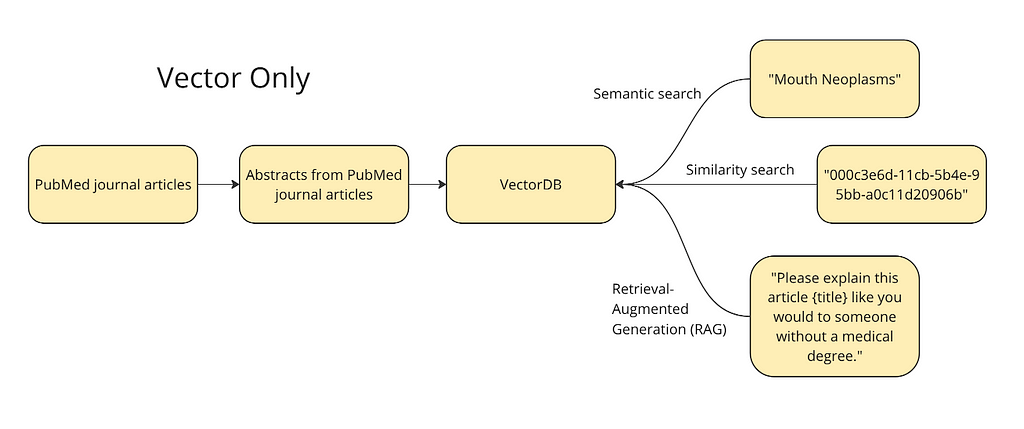
I’ve decided to use this dataset of 50,000 research articles from the PubMed repository (License CC0: Public Domain). This dataset contains the title of the articles, their abstracts, as well as a field for metadata tags. These tags are from the Medical Subject Headings (MeSH) controlled vocabulary thesaurus. For the purposes of this part of the tutorial, we are only going to use the abstracts and the titles. This is because we are trying to compare a vector database with a knowledge graph and the strength of the vector database is in its ability to ‘understand’ unstructured data without rich metadata. I only used the top 10,000 rows of the data, just to make the calculations run faster.
Here is Weaviate’s official quickstart tutorial. I also found this article helpful in getting started.
from weaviate.util import generate_uuid5
import weaviate
import json
import pandas as pd
#Read in the pubmed data
df = pd.read_csv("PubMed Multi Label Text Classification Dataset Processed.csv")
Then we can establish a connection to our Weaviate cluster:
client = weaviate.Client(
url = "XXX", # Replace with your Weaviate endpoint
auth_client_secret=weaviate.auth.AuthApiKey(api_key="XXX"), # Replace with your Weaviate instance API key
additional_headers = {
"X-OpenAI-Api-Key": "XXX" # Replace with your inference API key
}
)
Before we vectorize the data into the vector database, we must define the schema. Here is where we define which columns from the csv we want to vectorize. As mentioned, for the purposes of this tutorial, to start, I only want to vectorize the title and abstract columns.
class_obj = {
# Class definition
"class": "articles",
# Property definitions
"properties": [
{
"name": "title",
"dataType": ["text"],
},
{
"name": "abstractText",
"dataType": ["text"],
},
],
# Specify a vectorizer
"vectorizer": "text2vec-openai",
# Module settings
"moduleConfig": {
"text2vec-openai": {
"vectorizeClassName": True,
"model": "ada",
"modelVersion": "002",
"type": "text"
},
"qna-openai": {
"model": "gpt-3.5-turbo-instruct"
},
"generative-openai": {
"model": "gpt-3.5-turbo"
}
},
}
Then we push this schema to our Weaviate cluster:
client.schema.create_class(class_obj)
You can check that this worked by looking directly in your Weaviate cluster.
Now that we have established the schema, we can write all of our data into the vector database.
import logging
import numpy as np
# Configure logging
logging.basicConfig(level=logging.INFO, format='%(asctime)s %(levelname)s %(message)s')
# Replace infinity values with NaN and then fill NaN values
df.replace([np.inf, -np.inf], np.nan, inplace=True)
df.fillna('', inplace=True)
# Convert columns to string type
df['Title'] = df['Title'].astype(str)
df['abstractText'] = df['abstractText'].astype(str)
# Log the data types
logging.info(f"Title column type: {df['Title'].dtype}")
logging.info(f"abstractText column type: {df['abstractText'].dtype}")
with client.batch(
batch_size=10, # Specify batch size
num_workers=2, # Parallelize the process
) as batch:
for index, row in df.iterrows():
try:
question_object = {
"title": row.Title,
"abstractText": row.abstractText,
}
batch.add_data_object(
question_object,
class_name="articles",
uuid=generate_uuid5(question_object)
)
except Exception as e:
logging.error(f"Error processing row {index}: {e}")
To check that the data went into the cluster, you can run this:
client.query.aggregate("articles").with_meta_count().do()
For some reason, only 9997 of my rows were vectorized. ¯_(ツ)_/¯
When we talk about semantics in the vector database, we mean that the terms are vectorized into the vector space using the LLM API which has been trained on lots of unstructured content. This means that the vector takes the context of the terms into consideration. For example, if the term Mark Twain is mentioned many times near the term Samuel Clemens in the training data, the vectors for these two terms should be close to each other in the vector space. Likewise, if the term Mouth Cancer appears together with Mouth Neoplasms many times in the training data, we would expect the vector for an article about Mouth Cancer to be near an article about Mouth Neoplasms in the vector space.
You can check that it worked by running a simple query:
response = (
client.query
.get("articles", ["title","abstractText"])
.with_additional(["id"])
.with_near_text({"concepts": ["Mouth Neoplasms"]})
.with_limit(10)
.do()
)
print(json.dumps(response, indent=4))
Here are the results:
This is what we mean by semantic search — none of these articles have the word ‘mouth’ anywhere in their titles or abstracts. The first article is about gingival (gums) neoplasms, a subset of mouth neoplasms. The second article is about a gingival neoplasms that originated in the subject’s salivary gland, both subsets of mouth neoplasms. The third article is about mandibular neoplasms — which is, technically, according to the MeSH vocabulary not a subset of mouth neoplasms. Still, the vector database knew that a mandible is close to a mouth.
We can also use the vector database to find similar articles. I chose an article that was returned using the mouth neoplasms query above titled, “Gingival metastasis as first sign of multiorgan dissemination of epithelioid malignant mesothelioma.” Using the ID for that article, I can query the vector database for all similar entities:
response = (
client.query
.get("articles", ["title", "abstractText"])
.with_near_object({
"id": "a7690f03-66b9-5d17-b765-8c6eb21f99c8" #id for a given article
})
.with_limit(10)
.with_additional(["distance"])
.do()
)
print(json.dumps(response, indent=2))
The results are ranked in order of similarity. Similarity is calculated as distance in the vector space. As you can see, the top result is the Gingival article — this article is the most similar article to itself.
The other articles are:
All of these articles, one could argue, are similar to our original gingival article. It is difficult to assess how similar they are and to therefore assess how well the similarity search performed because that is largely a matter of what the user means by similar. Were you interested in other articles about treatments for mesothelioma and the fact that the first article is about how it spread to the gums is irrelevant? In that case, Article 5 is the most similar. Or are you interested in reducing any type of mouth cancer, whether through treatment or prevention? In that case, Article 4 is the most similar. One drawback of the vector database, is that it is a black box — we have no idea why these articles were returned.
Here is how you can use the vector database to retrieve results which are then sent to an LLM for summarization — an example of RAG.
response = (
client.query
.get("articles", ["title", "abstractText"])
.with_near_text({"concepts": ["Gingival metastasis as first sign of multiorgan dissemination of epithelioid malignant mesothelioma"]})
.with_generate(single_prompt="Please explain this article {title} like you would to someone without a medical degree.")
.with_limit(1)
.do()
)
print(json.dumps(response, indent=4))
You can see the response below:
“Sure! This article is talking about a case where a person had a type of cancer called epithelioid malignant mesothelioma. This cancer usually starts in the lining of the lungs or abdomen. However, in this case, the first sign of the cancer spreading to other parts of the body was seen in the gums (gingiva). This is called gingival metastasis.nnMetastasis means that cancer cells have spread from the original tumor to other parts of the body. In this case, the cancer had spread to the gums before spreading to other organs. This is important because it shows that the cancer was already advanced and had spread to multiple organs before it was even detected.nnOverall, this article highlights the importance of early detection and monitoring of cancer, as well as the potential for cancer to spread to unexpected parts of the body.”
I am actually disappointed by this response. The abstract clearly explains that this is a study that follows 13 patients with metastatic malignant mesothelioma that underwent different treatments and the outcomes. The RAG output describes the article as about ‘a person’ and doesn’t mention the study at all.
Rather than just summarize one article, let’s try to summarize several. In this next example, we use the same search term as above (Mouth Neoplasms) and then send the top three articles along with a prompt, ‘Summarize the key information here in bullet points. Make it understandable to someone without a medical degree,’ to an LLM.
response = (
client.query
.get(collection_name, ["title", "abstractText"])
.with_near_text({"concepts": ["Mouth Neoplasms"]})
.with_limit(3)
.with_generate(grouped_task="Summarize the key information here in bullet points. Make it understandable to someone without a medical degree.")
.do()
)
print(response["data"]["Get"]["Articles"][0]["_additional"]["generate"]["groupedResult"])
Here are the results:
- Metastatic malignant mesothelioma to the oral cavity is rare, with more cases in jaw bones than soft tissue
- Average survival rate for this type of cancer is 9-12 months
- Study of 13 patients who underwent neoadjuvant chemotherapy and surgery showed a median survival of 11 months
- One patient had a gingival mass as the first sign of multiorgan recurrence of mesothelioma
- Biopsy of new growing lesions, even in uncommon sites, is important for patients with a history of mesothelioma
- Myoepithelioma of minor salivary gland origin can show features indicative of malignant potential
- Metastatic neuroblastoma in the mandible is very rare and can present with osteolytic jaw defects and looseness of deciduous molars in children
This looks better to me than the previous response — it mentions the study conducted in Article 1, the treatments, and the outcomes. The second to last bullet is about the “Myoepithelioma of minor salivary gland origin. Light and electron microscopical study,” article and seems to be an accurate one line description. The final bullet is about Article 3 referenced above, and, again, seems to be an accurate one line description.
Here is a high-level overview of how we use a knowledge graph for semantic search, similarity search, and RAG:
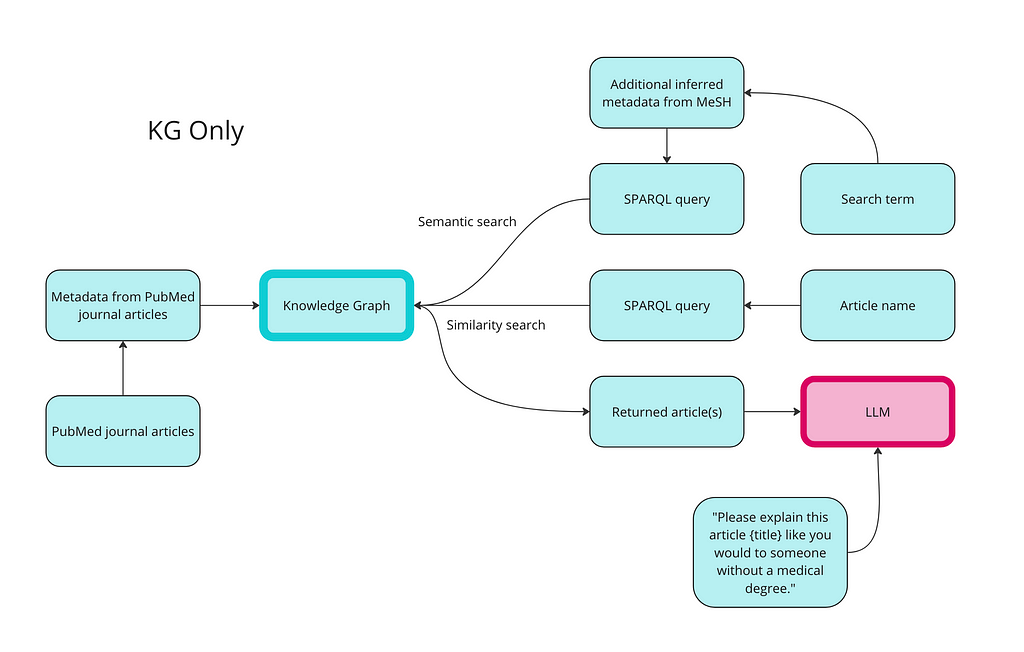
The first step of using a knowledge graph to retrieve your data is to turn your data into RDF format. The code below creates classes and properties for all of the data types, and then populates it with instances of articles and MeSH terms. I have also created properties for date published and access level and populated them with random values just as a demonstration.
from rdflib import Graph, RDF, RDFS, Namespace, URIRef, Literal
from rdflib.namespace import SKOS, XSD
import pandas as pd
import urllib.parse
import random
from datetime import datetime, timedelta
# Create a new RDF graph
g = Graph()
# Define namespaces
schema = Namespace('http://schema.org/')
ex = Namespace('http://example.org/')
prefixes = {
'schema': schema,
'ex': ex,
'skos': SKOS,
'xsd': XSD
}
for p, ns in prefixes.items():
g.bind(p, ns)
# Define classes and properties
Article = URIRef(ex.Article)
MeSHTerm = URIRef(ex.MeSHTerm)
g.add((Article, RDF.type, RDFS.Class))
g.add((MeSHTerm, RDF.type, RDFS.Class))
title = URIRef(schema.name)
abstract = URIRef(schema.description)
date_published = URIRef(schema.datePublished)
access = URIRef(ex.access)
g.add((title, RDF.type, RDF.Property))
g.add((abstract, RDF.type, RDF.Property))
g.add((date_published, RDF.type, RDF.Property))
g.add((access, RDF.type, RDF.Property))
# Function to clean and parse MeSH terms
def parse_mesh_terms(mesh_list):
if pd.isna(mesh_list):
return []
return [term.strip().replace(' ', '_') for term in mesh_list.strip("[]'").split(',')]
# Function to create a valid URI
def create_valid_uri(base_uri, text):
if pd.isna(text):
return None
sanitized_text = urllib.parse.quote(text.strip().replace(' ', '_').replace('"', '').replace('<', '').replace('>', '').replace("'", "_"))
return URIRef(f"{base_uri}/{sanitized_text}")
# Function to generate a random date within the last 5 years
def generate_random_date():
start_date = datetime.now() - timedelta(days=5*365)
random_days = random.randint(0, 5*365)
return start_date + timedelta(days=random_days)
# Function to generate a random access value between 1 and 10
def generate_random_access():
return random.randint(1, 10)
# Load your DataFrame here
# df = pd.read_csv('your_data.csv')
# Loop through each row in the DataFrame and create RDF triples
for index, row in df.iterrows():
article_uri = create_valid_uri("http://example.org/article", row['Title'])
if article_uri is None:
continue
# Add Article instance
g.add((article_uri, RDF.type, Article))
g.add((article_uri, title, Literal(row['Title'], datatype=XSD.string)))
g.add((article_uri, abstract, Literal(row['abstractText'], datatype=XSD.string)))
# Add random datePublished and access
random_date = generate_random_date()
random_access = generate_random_access()
g.add((article_uri, date_published, Literal(random_date.date(), datatype=XSD.date)))
g.add((article_uri, access, Literal(random_access, datatype=XSD.integer)))
# Add MeSH Terms
mesh_terms = parse_mesh_terms(row['meshMajor'])
for term in mesh_terms:
term_uri = create_valid_uri("http://example.org/mesh", term)
if term_uri is None:
continue
# Add MeSH Term instance
g.add((term_uri, RDF.type, MeSHTerm))
g.add((term_uri, RDFS.label, Literal(term.replace('_', ' '), datatype=XSD.string)))
# Link Article to MeSH Term
g.add((article_uri, schema.about, term_uri))
# Serialize the graph to a file (optional)
g.serialize(destination='ontology.ttl', format='turtle')
Now we can test semantic search. The word semantic is slightly different in the context of knowledge graphs, however. In the knowledge graph, we are relying on the tags associated with the documents and their relationships in the MeSH taxonomy for the semantics. For example, an article might be about Salivary Neoplasms (cancer in the salivary glands) but still be tagged with the term Mouth Neoplasms.
Rather than query all articles tagged with Mouth Neoplasms, we will also look for any concept narrower than Mouth Neoplasms. The MeSH vocabulary contains definitions of terms but it also contains relationships like broader and narrower.
from SPARQLWrapper import SPARQLWrapper, JSON
def get_concept_triples_for_term(term):
sparql = SPARQLWrapper("https://id.nlm.nih.gov/mesh/sparql")
query = f"""
PREFIX rdf: <http://www.w3.org/1999/02/22-rdf-syntax-ns#>
PREFIX rdfs: <http://www.w3.org/2000/01/rdf-schema#>
PREFIX meshv: <http://id.nlm.nih.gov/mesh/vocab#>
PREFIX mesh: <http://id.nlm.nih.gov/mesh/>
SELECT ?subject ?p ?pLabel ?o ?oLabel
FROM <http://id.nlm.nih.gov/mesh>
WHERE {{
?subject rdfs:label "{term}"@en .
?subject ?p ?o .
FILTER(CONTAINS(STR(?p), "concept"))
OPTIONAL {{ ?p rdfs:label ?pLabel . }}
OPTIONAL {{ ?o rdfs:label ?oLabel . }}
}}
"""
sparql.setQuery(query)
sparql.setReturnFormat(JSON)
results = sparql.query().convert()
triples = set() # Using a set to avoid duplicate entries
for result in results["results"]["bindings"]:
obj_label = result.get("oLabel", {}).get("value", "No label")
triples.add(obj_label)
# Add the term itself to the list
triples.add(term)
return list(triples) # Convert back to a list for easier handling
def get_narrower_concepts_for_term(term):
sparql = SPARQLWrapper("https://id.nlm.nih.gov/mesh/sparql")
query = f"""
PREFIX rdf: <http://www.w3.org/1999/02/22-rdf-syntax-ns#>
PREFIX rdfs: <http://www.w3.org/2000/01/rdf-schema#>
PREFIX meshv: <http://id.nlm.nih.gov/mesh/vocab#>
PREFIX mesh: <http://id.nlm.nih.gov/mesh/>
SELECT ?narrowerConcept ?narrowerConceptLabel
WHERE {{
?broaderConcept rdfs:label "{term}"@en .
?narrowerConcept meshv:broaderDescriptor ?broaderConcept .
?narrowerConcept rdfs:label ?narrowerConceptLabel .
}}
"""
sparql.setQuery(query)
sparql.setReturnFormat(JSON)
results = sparql.query().convert()
concepts = set() # Using a set to avoid duplicate entries
for result in results["results"]["bindings"]:
subject_label = result.get("narrowerConceptLabel", {}).get("value", "No label")
concepts.add(subject_label)
return list(concepts) # Convert back to a list for easier handling
def get_all_narrower_concepts(term, depth=2, current_depth=1):
# Create a dictionary to store the terms and their narrower concepts
all_concepts = {}
# Initial fetch for the primary term
narrower_concepts = get_narrower_concepts_for_term(term)
all_concepts[term] = narrower_concepts
# If the current depth is less than the desired depth, fetch narrower concepts recursively
if current_depth < depth:
for concept in narrower_concepts:
# Recursive call to fetch narrower concepts for the current concept
child_concepts = get_all_narrower_concepts(concept, depth, current_depth + 1)
all_concepts.update(child_concepts)
return all_concepts
# Fetch alternative names and narrower concepts
term = "Mouth Neoplasms"
alternative_names = get_concept_triples_for_term(term)
all_concepts = get_all_narrower_concepts(term, depth=2) # Adjust depth as needed
# Output alternative names
print("Alternative names:", alternative_names)
print()
# Output narrower concepts
for broader, narrower in all_concepts.items():
print(f"Broader concept: {broader}")
print(f"Narrower concepts: {narrower}")
print("---")
Below are all of the alternative names and narrower concepts for Mouth Neoplasms.
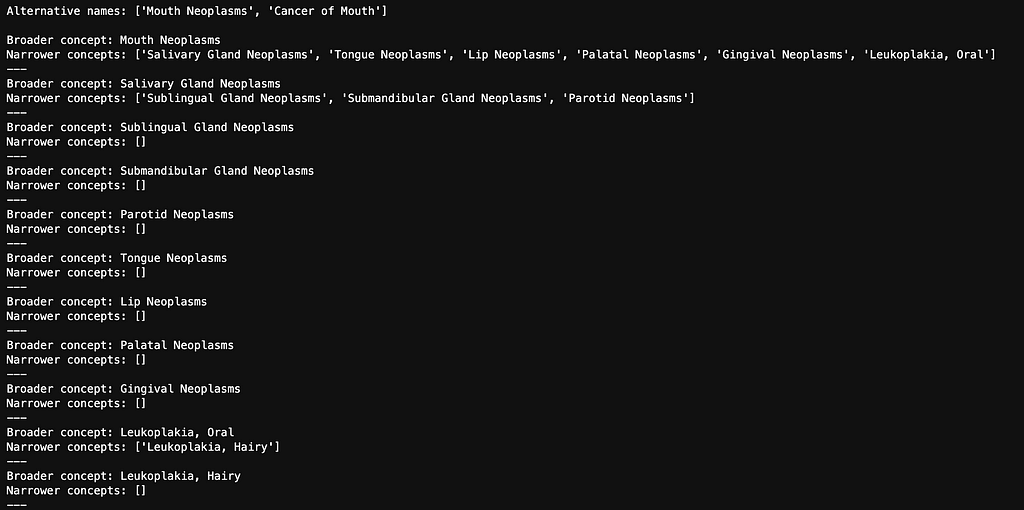
We turn this into a flat list of terms:
def flatten_concepts(concepts_dict):
flat_list = []
def recurse_terms(term_dict):
for term, narrower_terms in term_dict.items():
flat_list.append(term)
if narrower_terms:
recurse_terms(dict.fromkeys(narrower_terms, [])) # Use an empty dict to recurse
recurse_terms(concepts_dict)
return flat_list
# Flatten the concepts dictionary
flat_list = flatten_concepts(all_concepts)
Then we turn the terms into MeSH URIs so we can incorporate them into our SPARQL query:
#Convert the MeSH terms to URI
def convert_to_mesh_uri(term):
formatted_term = term.replace(" ", "_").replace(",", "_").replace("-", "_")
return URIRef(f"http://example.org/mesh/_{formatted_term}_")
# Convert terms to URIs
mesh_terms = [convert_to_mesh_uri(term) for term in flat_list]
Then we write a SPARQL query to find all articles that are tagged with ‘Mouth Neoplasms’, its alternative name, ‘Cancer of Mouth,’ or any of the narrower terms:
from rdflib import URIRef
query = """
PREFIX schema: <http://schema.org/>
PREFIX ex: <http://example.org/>
SELECT ?article ?title ?abstract ?datePublished ?access ?meshTerm
WHERE {
?article a ex:Article ;
schema:name ?title ;
schema:description ?abstract ;
schema:datePublished ?datePublished ;
ex:access ?access ;
schema:about ?meshTerm .
?meshTerm a ex:MeSHTerm .
}
"""
# Dictionary to store articles and their associated MeSH terms
article_data = {}
# Run the query for each MeSH term
for mesh_term in mesh_terms:
results = g.query(query, initBindings={'meshTerm': mesh_term})
# Process results
for row in results:
article_uri = row['article']
if article_uri not in article_data:
article_data[article_uri] = {
'title': row['title'],
'abstract': row['abstract'],
'datePublished': row['datePublished'],
'access': row['access'],
'meshTerms': set()
}
# Add the MeSH term to the set for this article
article_data[article_uri]['meshTerms'].add(str(row['meshTerm']))
# Rank articles by the number of matching MeSH terms
ranked_articles = sorted(
article_data.items(),
key=lambda item: len(item[1]['meshTerms']),
reverse=True
)
# Get the top 3 articles
top_3_articles = ranked_articles[:3]
# Output results
for article_uri, data in top_3_articles:
print(f"Title: {data['title']}")
print("MeSH Terms:")
for mesh_term in data['meshTerms']:
print(f" - {mesh_term}")
print()
The articles returned are:
These results are not dissimilar to what we got from the vector database. Each of these articles is about mouth neoplasms. What is nice about the knowledge graph approach is that we do get explainability — we know exactly why these articles were chosen. Article 2 is tagged with “Gingival Neoplasms”, and “Salivary Gland Neoplasms.” Articles 4 and 6 are both tagged with “Mouth Neoplasms.” Since Article 2 is tagged with 2 matching terms from our search terms, it is ranked highest.
Rather than using a vector space to find similar articles, we can rely on the tags associated with articles. There are different ways of doing similarity using tags, but for this example, I will use a common method: Jaccard Similarity. We will use the gingival article again for comparison across methods.
from rdflib import Graph, URIRef
from rdflib.namespace import RDF, RDFS, Namespace, SKOS
import urllib.parse
# Define namespaces
schema = Namespace('http://schema.org/')
ex = Namespace('http://example.org/')
rdfs = Namespace('http://www.w3.org/2000/01/rdf-schema#')
# Function to calculate Jaccard similarity and return overlapping terms
def jaccard_similarity(set1, set2):
intersection = set1.intersection(set2)
union = set1.union(set2)
similarity = len(intersection) / len(union) if len(union) != 0 else 0
return similarity, intersection
# Load the RDF graph
g = Graph()
g.parse('ontology.ttl', format='turtle')
def get_article_uri(title):
# Convert the title to a URI-safe string
safe_title = urllib.parse.quote(title.replace(" ", "_"))
return URIRef(f"http://example.org/article/{safe_title}")
def get_mesh_terms(article_uri):
query = """
PREFIX schema: <http://schema.org/>
PREFIX ex: <http://example.org/>
PREFIX rdfs: <http://www.w3.org/2000/01/rdf-schema#>
SELECT ?meshTerm
WHERE {
?article schema:about ?meshTerm .
?meshTerm a ex:MeSHTerm .
FILTER (?article = <""" + str(article_uri) + """>)
}
"""
results = g.query(query)
mesh_terms = {str(row['meshTerm']) for row in results}
return mesh_terms
def find_similar_articles(title):
article_uri = get_article_uri(title)
mesh_terms_given_article = get_mesh_terms(article_uri)
# Query all articles and their MeSH terms
query = """
PREFIX schema: <http://schema.org/>
PREFIX ex: <http://example.org/>
PREFIX rdfs: <http://www.w3.org/2000/01/rdf-schema#>
SELECT ?article ?meshTerm
WHERE {
?article a ex:Article ;
schema:about ?meshTerm .
?meshTerm a ex:MeSHTerm .
}
"""
results = g.query(query)
mesh_terms_other_articles = {}
for row in results:
article = str(row['article'])
mesh_term = str(row['meshTerm'])
if article not in mesh_terms_other_articles:
mesh_terms_other_articles[article] = set()
mesh_terms_other_articles[article].add(mesh_term)
# Calculate Jaccard similarity
similarities = {}
overlapping_terms = {}
for article, mesh_terms in mesh_terms_other_articles.items():
if article != str(article_uri):
similarity, overlap = jaccard_similarity(mesh_terms_given_article, mesh_terms)
similarities[article] = similarity
overlapping_terms[article] = overlap
# Sort by similarity and get top 5
top_similar_articles = sorted(similarities.items(), key=lambda x: x[1], reverse=True)[:15]
# Print results
print(f"Top 15 articles similar to '{title}':")
for article, similarity in top_similar_articles:
print(f"Article URI: {article}")
print(f"Jaccard Similarity: {similarity:.4f}")
print(f"Overlapping MeSH Terms: {overlapping_terms[article]}")
print()
# Example usage
article_title = "Gingival metastasis as first sign of multiorgan dissemination of epithelioid malignant mesothelioma."
find_similar_articles(article_title)
The results are below. Since we are searching on the Gingival article again, that is the most similar article, which is what we would expect. The other results are:
The best part of this method is that, because of the way we are calculating similarity here, we can see WHY the other articles are similar — we see exactly which terms are overlapping i.e. which terms are common on the Gingival article and each of the comparisons.
The downside of explainability is that we can see that these do not seem like the most similar articles, given the previous results. They all have three terms in common (Aged, Male, and Humans) that are probably not nearly as relevant as Treatment Options or Mouth Neoplasms. You could re-calculate using some weight based on the prevalence of the term across the corpus — Term Frequency-Inverse Document Frequency (TF-IDF) — which would probably improve the results. You could also select the tagged terms that are most relevant for you when conducting similarity for more control over the results.
The biggest downside of using Jaccard similarity on terms in a knowledge graph for calculating similarity is the computational efforts — it took like 30 minutes to run this one calculation.
We can also do RAG using just the knowledge graph for the retrieval part. We already have a list of articles about mouth neoplasms saved as results from the semantic search above. To implement RAG, we just want to send these articles to an LLM and ask it to summarize the results.
First we combine the titles and abstracts for each of the articles into one big chunk of text called combined_text:
# Function to combine titles and abstracts
def combine_abstracts(top_3_articles):
combined_text = "".join(
[f"Title: {data['title']} Abstract: {data['abstract']}" for article_uri, data in top_3_articles]
)
return combined_text
# Combine abstracts from the top 3 articles
combined_text = combine_abstracts(top_3_articles)
print(combined_text)
We then set up a client so that we can send this text directly to an LLM:
import openai
# Set up your OpenAI API key
api_key = "YOUR API KEY"
openai.api_key = api_key
Then we give the context and the prompt to the LLM:
def generate_summary(combined_text):
response = openai.Completion.create(
model="gpt-3.5-turbo-instruct",
prompt=f"Summarize the key information here in bullet points. Make it understandable to someone without a medical degree:nn{combined_text}",
max_tokens=1000,
temperature=0.3
)
# Get the raw text output
raw_summary = response.choices[0].text.strip()
# Split the text into lines and clean up whitespace
lines = raw_summary.split('n')
lines = [line.strip() for line in lines if line.strip()]
# Join the lines back together with actual line breaks
formatted_summary = 'n'.join(lines)
return formatted_summary
# Generate and print the summary
summary = generate_summary(combined_text)
print(summary)
The results look as follows:
- A 14-year-old boy had a gingival tumor in his anterior maxilla that was removed and studied by light and electron microscopy
- The tumor was made up of myoepithelial cells and appeared to be malignant
- Electron microscopy showed that the tumor originated from a salivary gland
- This is the only confirmed case of a myoepithelioma with features of malignancy
- A feasibility study was conducted to improve early detection of oral cancer and premalignant lesions in a high incidence region
- Tobacco vendors were involved in distributing flyers to invite smokers for free examinations by general practitioners
- 93 patients were included in the study and 27% were referred to a specialist
- 63.6% of those referred actually saw a specialist and 15.3% were confirmed to have a premalignant lesion
- A study found a correlation between increased expression of the protein HuR and the enzyme COX-2 in oral squamous cell carcinoma (OSCC)
- Cytoplasmic HuR expression was associated with COX-2 expression and lymph node and distant metastasis in OSCCs
- Inhibition of HuR expression led to a decrease in COX-2 expression in oral cancer cells.
The results look good i.e. it is a good summary of the three articles that were returned from the semantic search. The quality of the response from a RAG application using a KG alone is a function of the ability of your KG to retrieve relevant documents. As seen in this example, if your prompt is simple enough, like, “summarize the key information here,” then the hard part is the retrieval (giving the LLM the correct articles as context), not in generating the response.
Now we want to combine forces. We will add a URIs to each article in the database and then create a new collection in Weaviate where we vectorize the article name, abstract, the MeSH terms associated with it, as well as the URI. The URI is a unique identifier for the article and a way for us to connect back to the knowledge graph.
First we add a new column in the data for the URI:
# Function to create a valid URI
def create_valid_uri(base_uri, text):
if pd.isna(text):
return None
# Encode text to be used in URI
sanitized_text = urllib.parse.quote(text.strip().replace(' ', '_').replace('"', '').replace('<', '').replace('>', '').replace("'", "_"))
return URIRef(f"{base_uri}/{sanitized_text}")
# Add a new column to the DataFrame for the article URIs
df['Article_URI'] = df['Title'].apply(lambda title: create_valid_uri("http://example.org/article", title))
Now we create a new schema for the new collection with the additional fields:
class_obj = {
# Class definition
"class": "articles_with_abstracts_and_URIs",
# Property definitions
"properties": [
{
"name": "title",
"dataType": ["text"],
},
{
"name": "abstractText",
"dataType": ["text"],
},
{
"name": "meshMajor",
"dataType": ["text"],
},
{
"name": "Article_URI",
"dataType": ["text"],
},
],
# Specify a vectorizer
"vectorizer": "text2vec-openai",
# Module settings
"moduleConfig": {
"text2vec-openai": {
"vectorizeClassName": True,
"model": "ada",
"modelVersion": "002",
"type": "text"
},
"qna-openai": {
"model": "gpt-3.5-turbo-instruct"
},
"generative-openai": {
"model": "gpt-3.5-turbo"
}
},
}
Push that schema to the vector database:
client.schema.create_class(class_obj)
Now we vectorize the data into the new collection:
import logging
import numpy as np
# Configure logging
logging.basicConfig(level=logging.INFO, format='%(asctime)s %(levelname)s %(message)s')
# Replace infinity values with NaN and then fill NaN values
df.replace([np.inf, -np.inf], np.nan, inplace=True)
df.fillna('', inplace=True)
# Convert columns to string type
df['Title'] = df['Title'].astype(str)
df['abstractText'] = df['abstractText'].astype(str)
df['meshMajor'] = df['meshMajor'].astype(str)
df['Article_URI'] = df['Article_URI'].astype(str)
# Log the data types
logging.info(f"Title column type: {df['Title'].dtype}")
logging.info(f"abstractText column type: {df['abstractText'].dtype}")
logging.info(f"meshMajor column type: {df['meshMajor'].dtype}")
logging.info(f"Article_URI column type: {df['Article_URI'].dtype}")
with client.batch(
batch_size=10, # Specify batch size
num_workers=2, # Parallelize the process
) as batch:
for index, row in df.iterrows():
try:
question_object = {
"title": row.Title,
"abstractText": row.abstractText,
"meshMajor": row.meshMajor,
"article_URI": row.Article_URI,
}
batch.add_data_object(
question_object,
class_name="articles_with_abstracts_and_URIs",
uuid=generate_uuid5(question_object)
)
except Exception as e:
logging.error(f"Error processing row {index}: {e}")
Now we can do semantic search over the vector database, just like before, but with more explainability and control over the results.
response = (
client.query
.get("articles_with_abstracts_and_URIs", ["title","abstractText","meshMajor","article_URI"])
.with_additional(["id"])
.with_near_text({"concepts": ["mouth neoplasms"]})
.with_limit(10)
.do()
)
print(json.dumps(response, indent=4))
The results are:
It is hard to say whether these results are better or worse than the KG or the vector database alone. In theory, the results should be better because the MeSH terms associated with each article are now vectorized alongside the articles. We are not really vectorizing the knowledge graph, however. The relationships between the MeSH terms, for example, are not in the vector database.
What is nice about having the MeSH terms vectorized is that there is some explainability right away — Article 11 is also tagged with Mouth Neoplasms, for example. But what is really cool about having the vector database connected to the knowledge graph is that we can apply any filters we want from the knowledge graph. Remember how we added in date published as a field in the data earlier? We can now filter on that. Suppose we want to find articles about mouth neoplasms published after May 1st, 2020:
from rdflib import Graph, Namespace, URIRef, Literal
from rdflib.namespace import RDF, RDFS, XSD
# Define namespaces
schema = Namespace('http://schema.org/')
ex = Namespace('http://example.org/')
rdfs = Namespace('http://www.w3.org/2000/01/rdf-schema#')
xsd = Namespace('http://www.w3.org/2001/XMLSchema#')
def get_articles_after_date(graph, article_uris, date_cutoff):
# Create a dictionary to store results for each URI
results_dict = {}
# Define the SPARQL query using a list of article URIs and a date filter
uris_str = " ".join(f"<{uri}>" for uri in article_uris)
query = f"""
PREFIX schema: <http://schema.org/>
PREFIX ex: <http://example.org/>
PREFIX rdfs: <http://www.w3.org/2000/01/rdf-schema#>
PREFIX xsd: <http://www.w3.org/2001/XMLSchema#>
SELECT ?article ?title ?datePublished
WHERE {{
VALUES ?article {{ {uris_str} }}
?article a ex:Article ;
schema:name ?title ;
schema:datePublished ?datePublished .
FILTER (?datePublished > "{date_cutoff}"^^xsd:date)
}}
"""
# Execute the query
results = graph.query(query)
# Extract the details for each article
for row in results:
article_uri = str(row['article'])
results_dict[article_uri] = {
'title': str(row['title']),
'date_published': str(row['datePublished'])
}
return results_dict
date_cutoff = "2023-01-01"
articles_after_date = get_articles_after_date(g, article_uris, date_cutoff)
# Output the results
for uri, details in articles_after_date.items():
print(f"Article URI: {uri}")
print(f"Title: {details['title']}")
print(f"Date Published: {details['date_published']}")
print()
The originally query returned ten results (we gave it a max of ten) but only six of these were published after Jan 1st, 2023. See the results below:
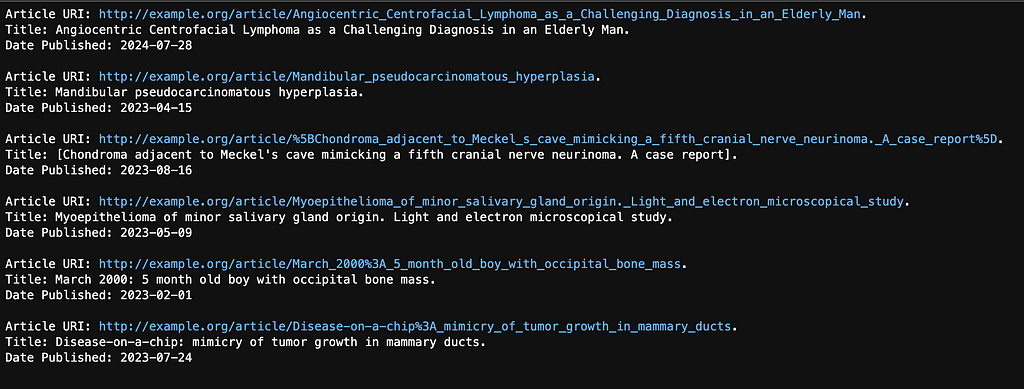
We can run a similarity search on this new collection just like we did before on our gingival article (Article 1):
response = (
client.query
.get("articles_with_abstracts_and_URIs", ["title","abstractText","meshMajor","article_URI"])
.with_near_object({
"id": "37b695c4-5b80-5f44-a710-e84abb46bc22"
})
.with_limit(50)
.with_additional(["distance"])
.do()
)
print(json.dumps(response, indent=2))
The results are below:
Since we have the MeSH tagged vectorized, we can see the tags associated with each article. Some of them, while perhaps similar in some respects, are not about mouth neoplasms. Suppose we want to find articles similar to our gingival article, but specifically about mouth neoplasms. We can now combine the SPARQL filtering we did with the knowledge graph earlier on these results.
The MeSH URIs for the synonyms and narrower concepts of Mouth Neoplasms is already saved, but do need the URIs for the 50 articles returned by the vector search:
# Assuming response is the data structure with your articles
article_uris = [URIRef(article["article_URI"]) for article in response["data"]["Get"]["Articles_with_abstracts_and_URIs"]]
Now we can rank the results based on the tags, just like we did before for semantic search using a knowledge graph.
from rdflib import URIRef
# Constructing the SPARQL query with a FILTER for the article URIs
query = """
PREFIX schema: <http://schema.org/>
PREFIX ex: <http://example.org/>
SELECT ?article ?title ?abstract ?datePublished ?access ?meshTerm
WHERE {
?article a ex:Article ;
schema:name ?title ;
schema:description ?abstract ;
schema:datePublished ?datePublished ;
ex:access ?access ;
schema:about ?meshTerm .
?meshTerm a ex:MeSHTerm .
# Filter to include only articles from the list of URIs
FILTER (?article IN (%s))
}
"""
# Convert the list of URIRefs into a string suitable for SPARQL
article_uris_string = ", ".join([f"<{str(uri)}>" for uri in article_uris])
# Insert the article URIs into the query
query = query % article_uris_string
# Dictionary to store articles and their associated MeSH terms
article_data = {}
# Run the query for each MeSH term
for mesh_term in mesh_terms:
results = g.query(query, initBindings={'meshTerm': mesh_term})
# Process results
for row in results:
article_uri = row['article']
if article_uri not in article_data:
article_data[article_uri] = {
'title': row['title'],
'abstract': row['abstract'],
'datePublished': row['datePublished'],
'access': row['access'],
'meshTerms': set()
}
# Add the MeSH term to the set for this article
article_data[article_uri]['meshTerms'].add(str(row['meshTerm']))
# Rank articles by the number of matching MeSH terms
ranked_articles = sorted(
article_data.items(),
key=lambda item: len(item[1]['meshTerms']),
reverse=True
)
# Output results
for article_uri, data in ranked_articles:
print(f"Title: {data['title']}")
print(f"Abstract: {data['abstract']}")
print("MeSH Terms:")
for mesh_term in data['meshTerms']:
print(f" - {mesh_term}")
print()
Of the 50 articles originally returned by the vector database, only five of them are tagged with Mouth Neoplasms or a related concept.
Finally, suppose we want to serve these similar articles to a user as a recommendation, but we only want to recommend the articles that that user has access to. Suppose we know that this user can only access articles tagged with access levels 3, 5, and 7. We can apply a filter in our knowledge graph using a similar SPARQL query:
from rdflib import Graph, Namespace, URIRef, Literal
from rdflib.namespace import RDF, RDFS, XSD, SKOS
# Assuming your RDF graph (g) is already loaded
# Define namespaces
schema = Namespace('http://schema.org/')
ex = Namespace('http://example.org/')
rdfs = Namespace('http://www.w3.org/2000/01/rdf-schema#')
def filter_articles_by_access(graph, article_uris, access_values):
# Construct the SPARQL query with a dynamic VALUES clause
uris_str = " ".join(f"<{uri}>" for uri in article_uris)
query = f"""
PREFIX schema: <http://schema.org/>
PREFIX ex: <http://example.org/>
PREFIX rdfs: <http://www.w3.org/2000/01/rdf-schema#>
SELECT ?article ?title ?abstract ?datePublished ?access ?meshTermLabel
WHERE {{
VALUES ?article {{ {uris_str} }}
?article a ex:Article ;
schema:name ?title ;
schema:description ?abstract ;
schema:datePublished ?datePublished ;
ex:access ?access ;
schema:about ?meshTerm .
?meshTerm rdfs:label ?meshTermLabel .
FILTER (?access IN ({", ".join(map(str, access_values))}))
}}
"""
# Execute the query
results = graph.query(query)
# Extract the details for each article
results_dict = {}
for row in results:
article_uri = str(row['article'])
if article_uri not in results_dict:
results_dict[article_uri] = {
'title': str(row['title']),
'abstract': str(row['abstract']),
'date_published': str(row['datePublished']),
'access': str(row['access']),
'mesh_terms': []
}
results_dict[article_uri]['mesh_terms'].append(str(row['meshTermLabel']))
return results_dict
access_values = [3,5,7]
filtered_articles = filter_articles_by_access(g, ranked_article_uris, access_values)
# Output the results
for uri, details in filtered_articles.items():
print(f"Article URI: {uri}")
print(f"Title: {details['title']}")
print(f"Abstract: {details['abstract']}")
print(f"Date Published: {details['date_published']}")
print(f"Access: {details['access']}")
print()
There was one article that the user did not have access to. The four remaining articles are:
Finally, let’s see how RAG works once we combine a vector database with a knowledge graph. As a reminder, you can run RAG directly against the vector database and send it to an LLM to get a generated response:
response = (
client.query
.get("Articles_with_abstracts_and_URIs", ["title", "abstractText",'article_URI','meshMajor'])
.with_near_text({"concepts": ["therapies for mouth neoplasms"]})
.with_limit(3)
.with_generate(grouped_task="Summarize the key information here in bullet points. Make it understandable to someone without a medical degree.")
.do()
)
print(response["data"]["Get"]["Articles_with_abstracts_and_URIs"][0]["_additional"]["generate"]["groupedResult"])
In this example, I am using the search term, ‘therapies for mouth neoplasms,’ with the same prompt, ‘Summarize the key information here in bullet points. Make it understandable to someone without a medical degree.’ We are only returning the top three articles to generate this response. Here are the results:
- Metastatic malignant mesothelioma to the oral cavity is rare, with an average survival rate of 9-12 months.
- Neoadjuvant chemotherapy and radical pleurectomy decortication followed by radiotherapy were used in 13 patients from August 2012 to September 2013.
- In January 2014, 11 patients were still alive with a median survival of 11 months, while 8 patients had a recurrence and 2 patients died at 8 and 9 months after surgery.
- A 68-year-old man had a gingival mass that turned out to be a metastatic deposit of malignant mesothelioma, leading to multiorgan recurrence.
- Biopsy is important for new growing lesions, even in uncommon sites, when there is a history of mesothelioma.
- Neoadjuvant radiochemotherapy for locally advanced rectal carcinoma can be effective, but some patients may not respond well.
- Genetic alterations may be associated with sensitivity or resistance to neoadjuvant therapy in rectal cancer.
- Losses of chromosomes 1p, 8p, 17p, and 18q, and gains of 1q and 13q were found in rectal cancer tumors.
- Alterations in specific chromosomal regions were associated with the response to neoadjuvant therapy.
- The cytogenetic profile of tumor cells may influence the response to radiochemotherapy in rectal cancer.
- Intensity-modulated radiation therapy for nasopharyngeal carcinoma achieved good long-term outcomes in terms of local control and overall survival.
- Acute toxicities included mucositis, dermatitis, and xerostomia, with most patients experiencing Grade 0-2 toxicities.
- Late toxicity mainly included xerostomia, which improved over time.
- Distant metastasis remained the main cause of treatment failure, highlighting the need for more effective systemic therapy.
As a test, we can see exactly which three articles were chosen:
# Extract article URIs
article_uris = [article["article_URI"] for article in response["data"]["Get"]["Articles_with_abstracts_and_URIs"]]
# Function to filter the response for only the given URIs
def filter_articles_by_uri(response, article_uris):
filtered_articles = []
articles = response['data']['Get']['Articles_with_abstracts_and_URIs']
for article in articles:
if article['article_URI'] in article_uris:
filtered_articles.append(article)
return filtered_articles
# Filter the response
filtered_articles = filter_articles_by_uri(response, article_uris)
# Output the filtered articles
print("Filtered articles:")
for article in filtered_articles:
print(f"Title: {article['title']}")
print(f"URI: {article['article_URI']}")
print(f"Abstract: {article['abstractText']}")
print(f"MeshMajor: {article['meshMajor']}")
print("---")
Interestingly, the first article is about gingival neoplasms, which is a subset of mouth neoplasms, but the second article is about rectal cancer, and the third is about nasopharyngeal cancer. They are about therapies for cancers, just not the kind of cancer I searched for. What is concerning is that the prompt was, “therapies for mouth neoplasms” and the results contain information about therapies for other kinds of cancer. This is what is sometimes called ‘context poisoning’ — irrelevant or misleading information is getting injected into the prompt which leads to misleading responses from the LLM.
We can use the KG to address the context poisoning. Here is a diagram of how the vector database and the KG can work together for a better RAG implementation:

First, we run a semantic search on the vector database using the same prompt: therapies for mouth cancer. I’ve upped the limit to 20 articles this time since we are going to filter some out.
response = (
client.query
.get("articles_with_abstracts_and_URIs", ["title", "abstractText", "meshMajor", "article_URI"])
.with_additional(["id"])
.with_near_text({"concepts": ["therapies for mouth neoplasms"]})
.with_limit(20)
.do()
)
# Extract article URIs
article_uris = [article["article_URI"] for article in response["data"]["Get"]["Articles_with_abstracts_and_URIs"]]
# Print the extracted article URIs
print("Extracted article URIs:")
for uri in article_uris:
print(uri)
Next we use the same sorting technique as before, using the Mouth Neoplasms related concepts:
from rdflib import URIRef
# Constructing the SPARQL query with a FILTER for the article URIs
query = """
PREFIX schema: <http://schema.org/>
PREFIX ex: <http://example.org/>
SELECT ?article ?title ?abstract ?datePublished ?access ?meshTerm
WHERE {
?article a ex:Article ;
schema:name ?title ;
schema:description ?abstract ;
schema:datePublished ?datePublished ;
ex:access ?access ;
schema:about ?meshTerm .
?meshTerm a ex:MeSHTerm .
# Filter to include only articles from the list of URIs
FILTER (?article IN (%s))
}
"""
# Convert the list of URIRefs into a string suitable for SPARQL
article_uris_string = ", ".join([f"<{str(uri)}>" for uri in article_uris])
# Insert the article URIs into the query
query = query % article_uris_string
# Dictionary to store articles and their associated MeSH terms
article_data = {}
# Run the query for each MeSH term
for mesh_term in mesh_terms:
results = g.query(query, initBindings={'meshTerm': mesh_term})
# Process results
for row in results:
article_uri = row['article']
if article_uri not in article_data:
article_data[article_uri] = {
'title': row['title'],
'abstract': row['abstract'],
'datePublished': row['datePublished'],
'access': row['access'],
'meshTerms': set()
}
# Add the MeSH term to the set for this article
article_data[article_uri]['meshTerms'].add(str(row['meshTerm']))
# Rank articles by the number of matching MeSH terms
ranked_articles = sorted(
article_data.items(),
key=lambda item: len(item[1]['meshTerms']),
reverse=True
)
# Output results
for article_uri, data in ranked_articles:
print(f"Title: {data['title']}")
print(f"Abstract: {data['abstract']}")
print("MeSH Terms:")
for mesh_term in data['meshTerms']:
print(f" - {mesh_term}")
print()
There are only three articles that are tagged with one of the Mouth Neoplasms terms:
Let’s send these to the LLM to see if the results improve:
# Filter the response
filtered_articles = filter_articles_by_uri(response, matching_articles)
# Function to combine titles and abstracts into one chunk of text
def combine_abstracts(filtered_articles):
combined_text = "nn".join(
[f"Title: {article['title']}nAbstract: {article['abstractText']}" for article in filtered_articles]
)
return combined_text
# Combine abstracts from the filtered articles
combined_text = combine_abstracts(filtered_articles)
# Generate and print the summary
summary = generate_summary(combined_text)
print(summary)
Here are the results:
- Oral cavity cancer is common and often not detected until it is advanced
- A feasibility study was conducted to improve early detection of oral cancer and premalignant lesions in a high-risk region
- Tobacco vendors were involved in distributing flyers to smokers for free examinations by general practitioners
- 93 patients were included in the study, with 27% being referred to a specialist
- 63.6% of referred patients actually saw a specialist, with 15.3% being diagnosed with a premalignant lesion
- Photodynamic therapy (PDT) was studied as an experimental cancer therapy in rats with chemically-induced premalignant lesions and squamous cell carcinoma of the palatal mucosa
- PDT was performed using Photofrin and two different activation wavelengths, with better results seen in the 514.5 nm group
- Gingival metastasis from malignant mesothelioma is extremely rare, with a low survival rate
- A case study showed a patient with a gingival mass as the first sign of multiorgan recurrence of malignant mesothelioma, highlighting the importance of biopsy for all new lesions, even in uncommon anatomical sites.
We can definitely see an improvement — these results are not about rectal cancer or nasopharyngeal neoplasms. This looks like a relatively accurate summary of the three articles selected, which are about therapies for mouth neoplasms
Overall, vector databases are great at getting search, similarity (recommendation), and RAG applications up and running quickly. There is little overhead required. If you have unstructured data associated with your structured data, like in this example of journal articles, it can work well. This would not work nearly as well if we didn’t have article abstracts as part of the dataset, for example.
KGs are great for accuracy and control. If you want to be sure that the data going into your search application is ‘right,’ and by ‘right’ I mean whatever you decide based on your needs, then a KG is going to be needed. KGs can work well for search and similarity, but the degree to which they will meet your needs will depend on the richness of your metadata, and the quality of the tagging. Quality of tagging might also mean different things depending on your use case — the way you build and apply a taxonomy to content might look different if you’re building a recommendation engine rather than a search engine.
Using a KG to filter results from a vector database leads to the best results. This is not surprising — I am using the KG to filter out irrelevant or misleading results as determined by me, so of course the results are better, according to me. But that’s the point: it’s not that the KG necessarily improves results by itself, it’s that the KG provides you the ability to control the output to optimize your results.
How to Implement Graph RAG Using Knowledge Graphs and Vector Databases was originally published in Towards Data Science on Medium, where people are continuing the conversation by highlighting and responding to this story.
Originally appeared here:
How to Implement Graph RAG Using Knowledge Graphs and Vector Databases
Go Here to Read this Fast! How to Implement Graph RAG Using Knowledge Graphs and Vector Databases
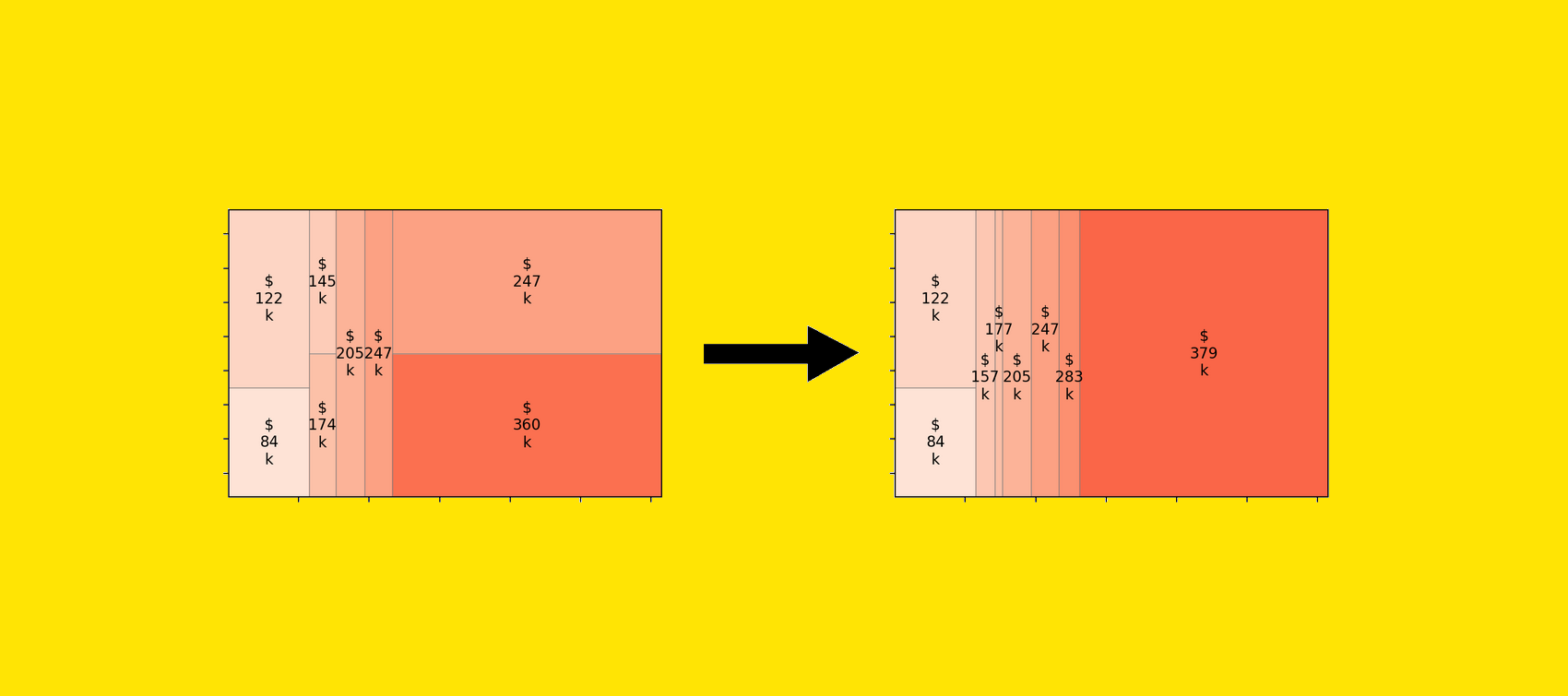
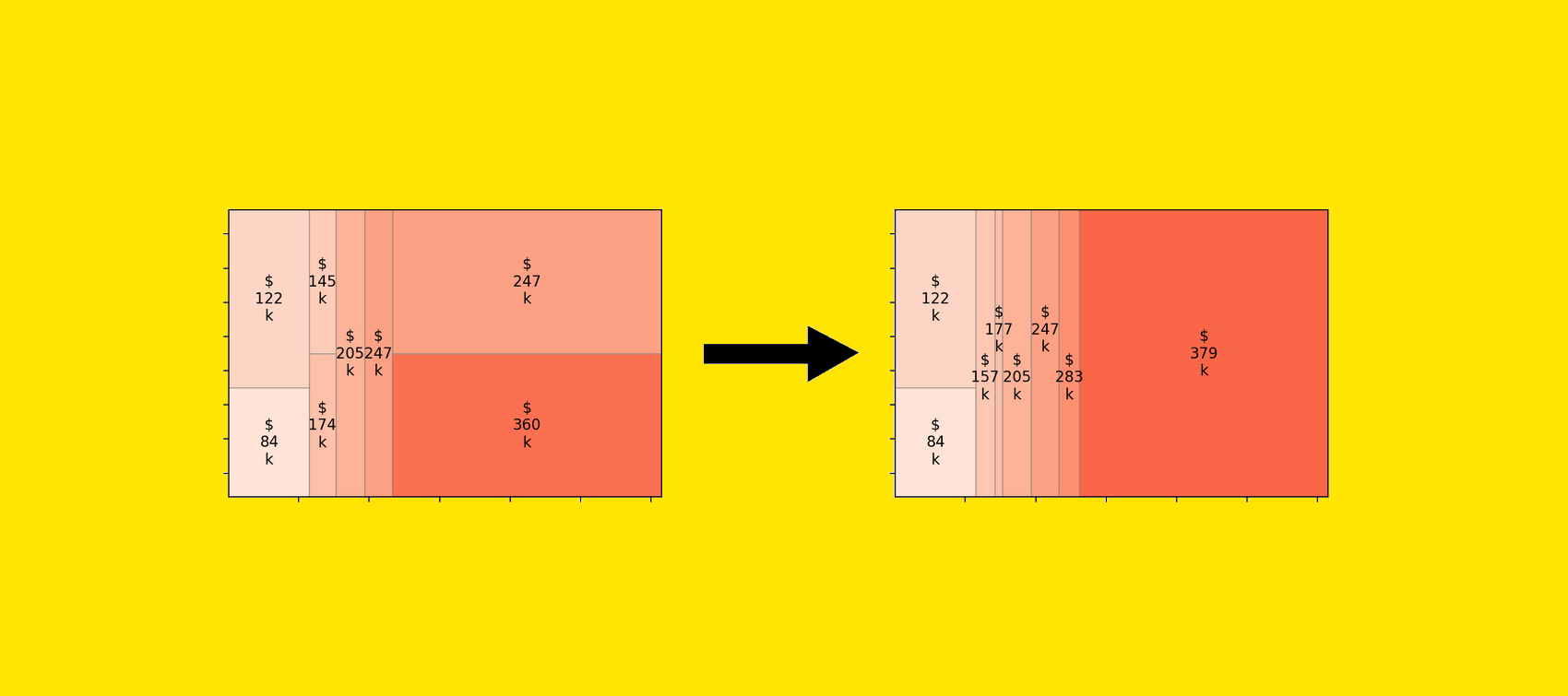
Monotonic constraints are key to making machine learning models actionable, yet they are still quite unused
Originally appeared here:
Causality in ML Models: Introducing Monotonic Constraints
Go Here to Read this Fast! Causality in ML Models: Introducing Monotonic Constraints
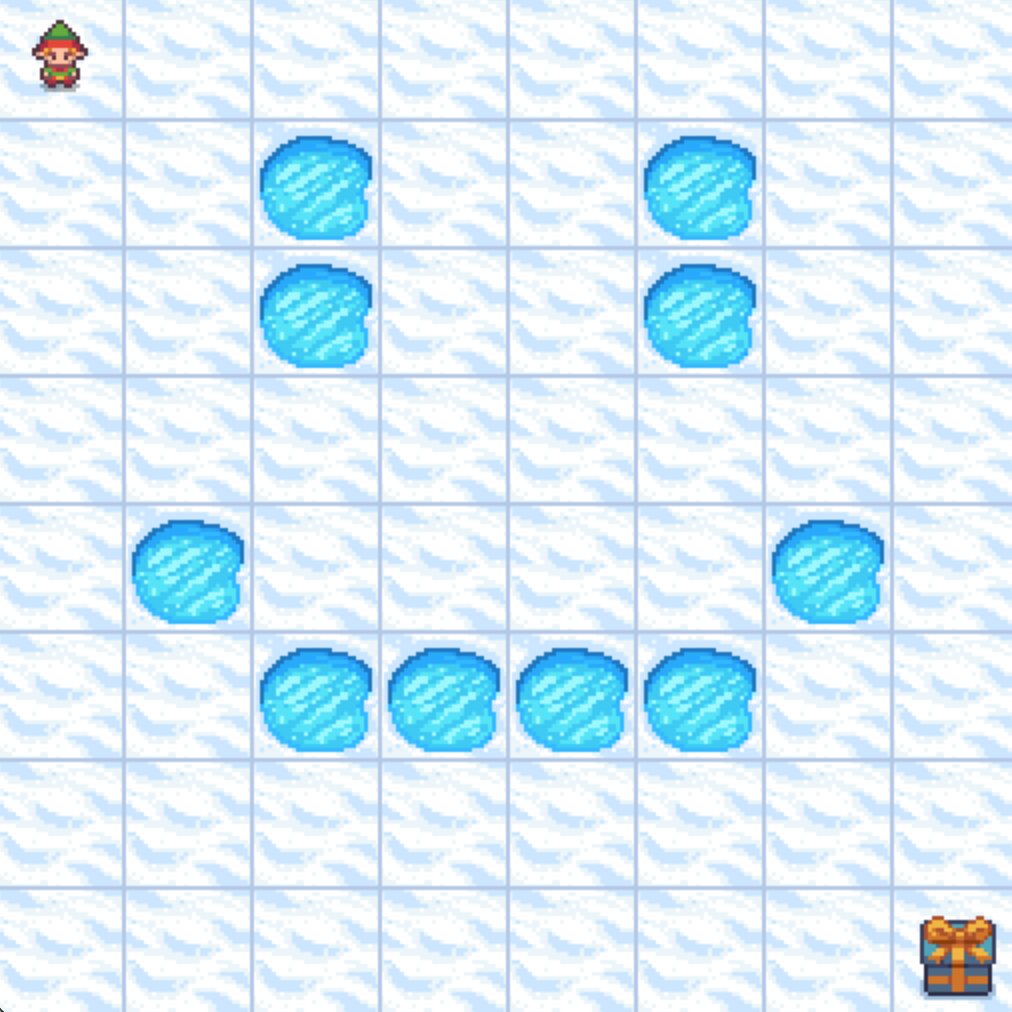
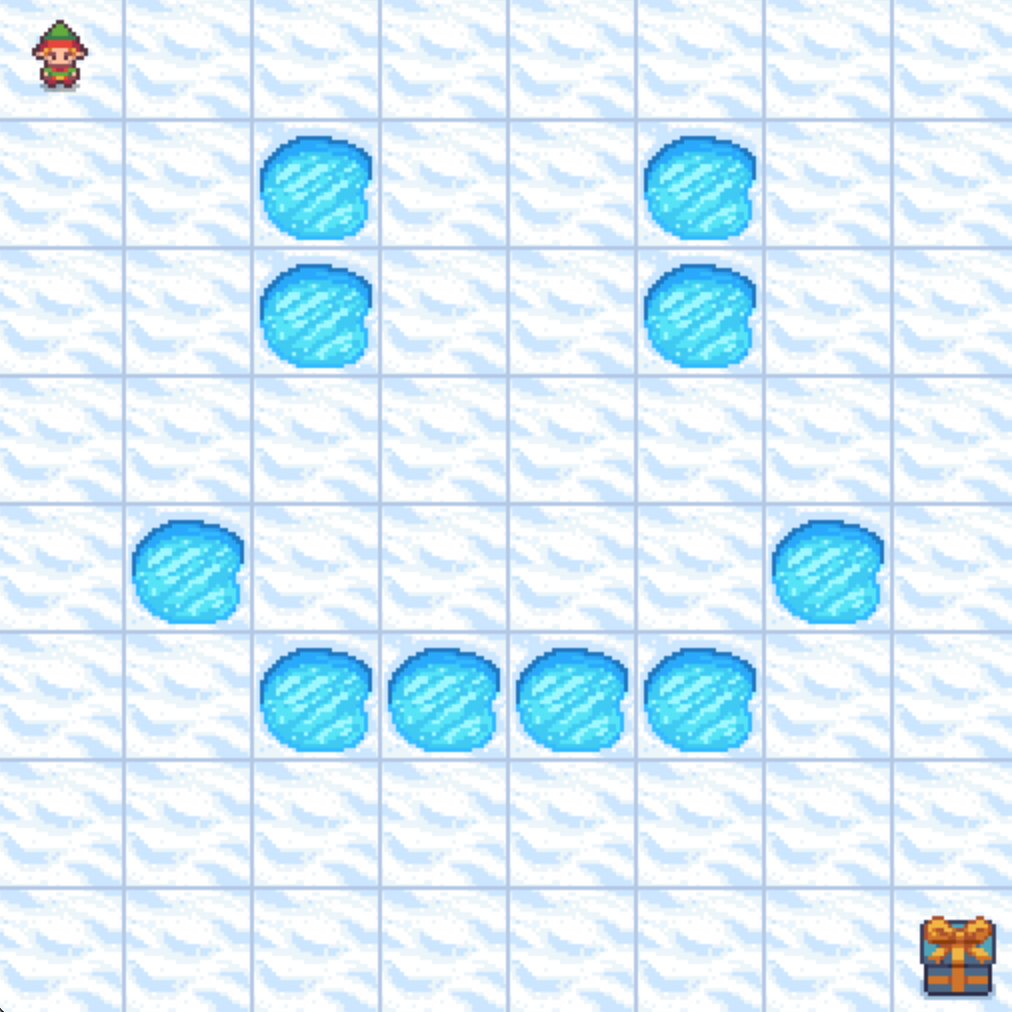
This is a guided series on introductory RL concepts using the environments from the OpenAI Gymnasium Python package. This first article will cover the high-level concepts necessary to understand and implement Q-learning to solve the “Frozen Lake” environment.
Happy learning ❤ !

Let’s explore reinforcement learning by comparing it to familiar examples from everyday life.
Card Game — Imagine playing a card game: When you first learn the game, the rules may be unclear. The cards you play might not be the most optimal and the strategies you use might be imperfect. As you play more and maybe win a few games, you learn what cards to play when and what strategies are better than others. Sometimes it’s better to bluff, but other times you should probably fold; saving a wild card for later use might be better than playing it immediately. Knowing what the optimal course of action is learned through a combination of experience and reward. Your experience comes from playing the game and you get rewarded when your strategies work well, perhaps leading to a victory or new high score.

Classical Conditioning — By ringing a bell before he fed a dog, Ivan Pavlov demonstrated the connection between external stimulus and a physiological response. The dog was conditioned to associate the sound of the bell with being fed and thus began to drool at the sound of the bell, even when no food was present. Though not strictly an example of reinforcement learning, through repeated experiences where the dog was rewarded with food at the sound of the bell, it still learned to associate the two together.
Feedback Control — An application of control theory found in engineering disciplines where a system’s behaviour can be adjusted by providing feedback to a controller. As a subset of feedback control, reinforcement learning requires feedback from our current environment to influence our actions. By providing feedback in the form of reward, we can incentivize our agent to pick the optimal course of action.
Reinforcement learning is a learning process built on the accumulation of past experiences coupled with quantifiable reward. In each example, we illustrate how our experiences can influence our actions and how reinforcing a positive association between reward and response could potentially be used to solve certain problems. If we can learn to associate reward with an optimal action, we could derive an algorithm that will select actions that yield the highest probable reward.
In reinforcement learning, the “learner” is called the agent. The agent interacts with our environment and, through its actions, learns what is considered “good” or “bad” based on the reward it receives.
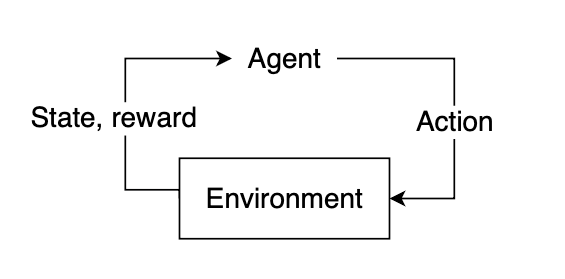
To select a course of action, our agent needs some information about our environment, given by the state. The state represents current information about the environment, such as position, velocity, time, etc. Our agent does not necessarily know the entirety of the current state. The information available to our agent at any given point in time is referred to as an observation, which contains some subset of information present in the state. Not all states are fully observable, and some states may require the agent to proceed knowing only a small fraction of what might actually be happening in the environment. Using the observation, our agent must infer what the best possible action might be based on learned experience and attempt to select the action that yields the highest expected reward.
After selecting an action, the environment will then respond by providing feedback in the form of an updated state and reward. This reward will help us determine if the action the agent took was optimal or not.
To better represent this problem, we might consider it as a Markov decision process (MDP). A MDP is a directed graph where each edge in the graph has a non-deterministic property. At each possible state in our graph, we have a set of actions we can choose from, with each action yielding some fixed reward and having some transitional probability of leading to some subsequent state. This means that the same actions are not guaranteed to lead to the same state every time since the transition from one state to another is not only dependent on the action, but the transitional probability as well.
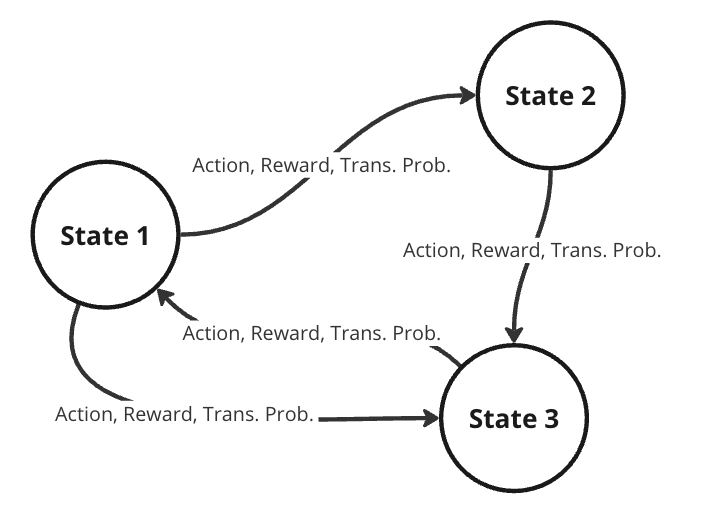
Randomness in decision models is useful in practical RL, allowing for dynamic environments where the agent lacks full control. Turn-based games like chess require the opponent to make a move before you can go again. If the opponent plays randomly, the future state of the board is never guaranteed, and our agent must play while accounting for a multitude of different probable future states. When the agent takes some action, the next state is dependent on what the opponent plays and is therefore defined by a probability distribution across possible moves for the opponent.
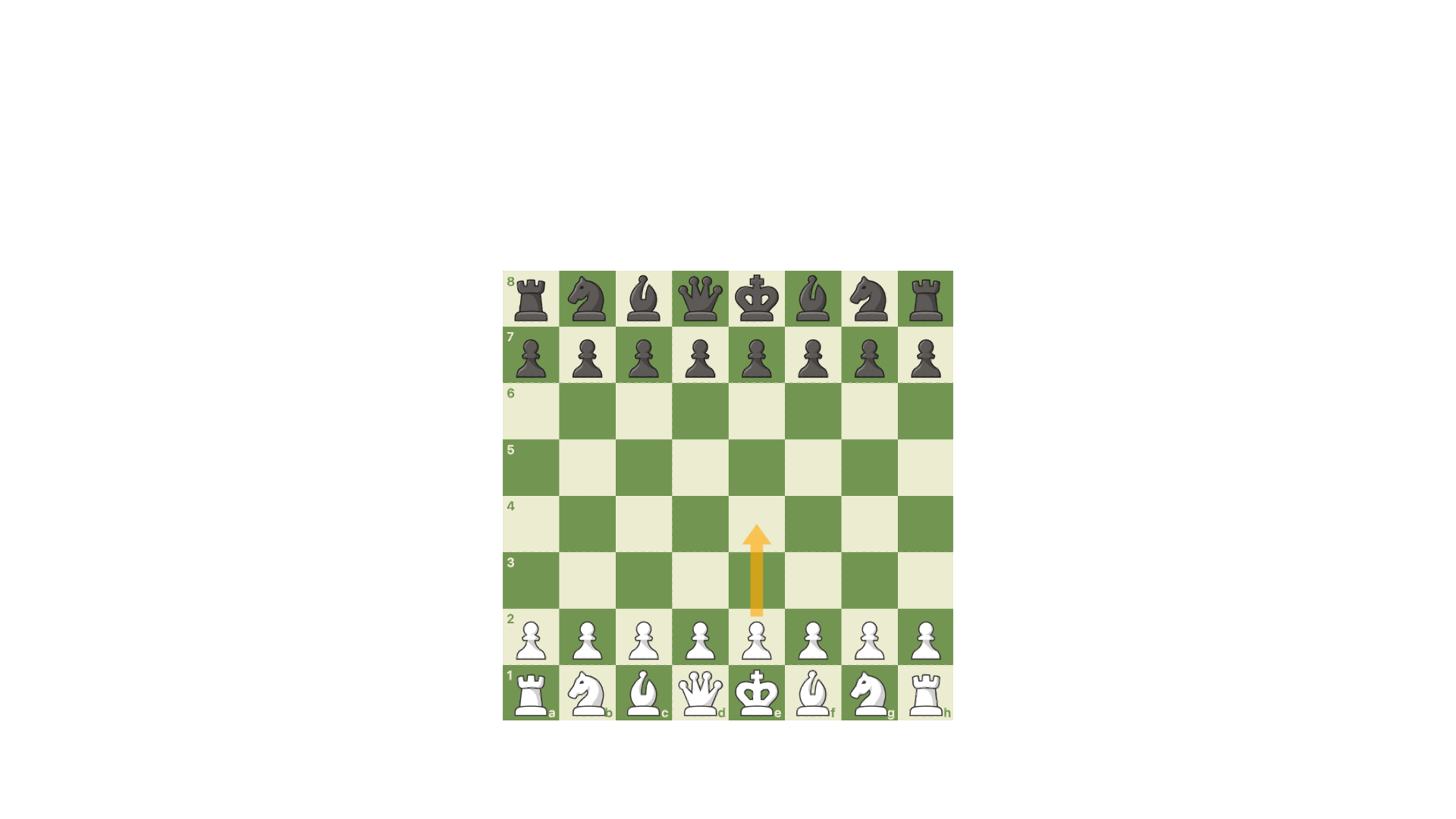
Our future state is therefore a function of both the probability of the agent selecting some action and the transitional probability of the opponent selecting some action. In general, we can assume that for any environment, the probability of our agent moving to some subsequent state from our current state is denoted by the joint probability of the agent selecting some action and the transitional probability of moving to that state.
To determine the optimal course of action, we want to provide our agent with lots of experience. Through repeated iterations of our environment, we aim to give the agent enough feedback that it can correctly choose the optimal action most, if not all, of the time. Recall our definition of reinforcement learning: a learning process built on the accumulation of past experiences coupled with quantifiable reward. After accumulating some experience, we want to use this experience to better select our future actions.
We can quantify our experiences by using them to predict the expected reward from future states. As we accumulate more experience, our predictions will become more accurate, converging to the true value after a certain number of iterations. For each reward that we receive, we can use that to update some information about our state, so the next time we encounter this state, we’ll have a better estimate of the reward that we might expect to receive.
Let’s consider consider a simple environment where our agent is a small character trying to navigate across a frozen lake, represented as a 2D grid. It can move in four directions: down, up, left, or right. Our goal is to teach it to move from its start position at the top left to an end position located at the bottom right of the map while avoiding the holes in the ice. If our agent manages to successfully reach its destination, we’ll give it a reward of +1. For all other cases, the agent will receive a reward of 0, with the added condition that if it falls into a hole, the exploration will immediately terminate.
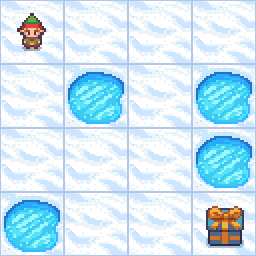
Each state can be denoted by its coordinate position in the grid, with the start position in the top left denoted as the origin (0, 0), and the bottom right ending position denoted as (3, 3).
The most generic solution would be to apply some pathfinding algorithm to find the shortest path to from top left to bottom right while avoiding holes in the ice. However, the probability that the agent can move from one state to another is not deterministic. Each time the agent tries to move, there is a 66% chance that it will “slip” and move to a random adjacent state. In other words, there is only a 33% chance of the action the agent chose actually occurring. A traditional pathfinding algorithm cannot handle the introduction of a transitional probability. Therefore, we need an algorithm that can handle stochastic environments, aka reinforcement learning.
This problem can easily be represented as a MDP, with each state in our grid having some transitional probability of moving to any adjacent state. To solve our MDP, we need to find the optimal course of action from any given state. Recall that if we can find a way to accurately predict the future rewards from each state, we can greedily choose the best possible path by selecting whichever state yields the highest expected reward. We will refer to this predicted reward as the state-value. More formally, the state-value will define the expected reward gained starting from some state plus an estimate of the expected rewards from all future states thereafter, assuming we act according to the same policy of choosing the highest expected reward. Initially, our agent will have no knowledge of what rewards to expect, so this estimate can be arbitrarily set to 0.
Let’s now define a way for us to select actions for our agent to take: We’ll begin with a table to store our predicted state-value estimates for each state, containing all zeros.

Our goal is to update these state-value estimates as we explore our environment. The more we traverse our environment, the more experience we will have, and the better our estimates will become. As our estimates improve, our state-values will become more accurate, and we will have a better representation of which states yield a higher reward, therefore allowing us to select actions based on which subsequent state has the highest state-value. This will surely work, right?
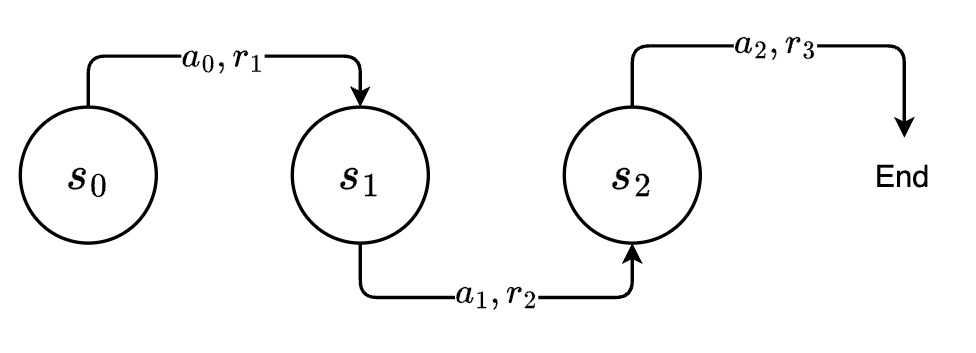
Nope, sorry. One immediate problem that you might notice is that simply selecting the next state based on the highest possible state-value isn’t going to work. When we look at the set of possible next states, we aren’t considering our current action—that is, the action that we will take from our current state to get to the next one. Based on our definition of reinforcement learning, the agent-environment feedback loop always consists of the agent taking some action and the environment responding with both state and reward. If we only look at the state-values for possible next states, we are considering the reward that we would receive starting from those states, which completely ignores the action (and consequent reward) we took to get there. Additionally, trying to select a maximum across the next possible states assumes we can even make it there in the first place. Sometimes, being a little more conservative will help us be more consistent in reaching the end goal; however, this is out of the scope of this article :(.
Instead of evaluating across the set of possible next states, we’d like to directly evaluate our available actions. If our previous state-value function consisted of the expected rewards starting from the next state, we’d like to update this function to now include the reward from taking an action from the current state to get to the next state, plus the expected rewards from there on. We’ll call this new estimate that includes our current action action-value.
We can now formally define our state-value and action-value functions based on rewards and transitional probability. We’ll use expected value to represent the relationship between reward and transitional probability. We’ll denote our state-value as V and our action-value as Q, based on standard conventions in RL literature.

The state-value V of some state s[t] is the expected sum of rewards r[t] at each state starting from s[t] to some future state s[T]; the action-value Q of some state s[t] is the expected sum of rewards r[t] at each state starting by taking an action a[t] to some future state-action pair s[T], a[T].
This definition is actually not the most accurate or conventional, and we’ll improve on it later. However, it serves as a general idea of what we’re looking for: a quantitative measure of future rewards.
Our state-value function V is an estimate of the maximum sum of rewards r we would obtain starting from state s and continually moving to the states that give the highest reward. Our action-value function is an estimate of the maximum reward we would obtain by taking action from some starting state and continually choosing the optimal actions that yield the highest reward thereafter. In both cases, we choose the optimal action/state to move to based on the expected reward that we would receive and loop this process until we either fall into a hole or reach our goal.
The method by which we choose our actions is called a policy. The policy is a function of state—given some state, it will output an action. In this case, since we want to select the next action based on maximizing the rewards, our policy can be defined as a function returning the action that yields the maximum action-value (Q-value) starting from our current state, or an argmax. Since we’re always selecting a maximum, we refer to this particular policy as greedy. We’ll denote our policy as a function of state s: π(s), formally defined as

To simplify our notation, we can also define a substitution for our sum of rewards, which we’ll call return, and a substitution for a sequence of states and actions, which we’ll call a trajectory. A trajectory, denoted by the Greek letter τ (tau), is denoted as

Since our environment is stochastic, it’s important to also consider the likelihood of such a trajectory occurring — low probability trajectories will reduce the expectation of reward. (Since our expected value consists of multiplying our reward by the transitional probability, trajectories that are less likely will have a lower expected reward compared to high probability ones.) The probability can be derived by considering the probability of each action and state happening incrementally: At any timestep in our MDP, we will select actions based on our policy, and the resulting state will be dependent on both the action we selected and the transitional probability. Without loss of generality, we’ll denote the transitional probability as a separate probability distribution, a function of both the current state and the attempted action. The conditional probability of some future state occurring is therefore defined as

And the probability of some action happening based on our policy is simply evaluated by passing our state into our policy function
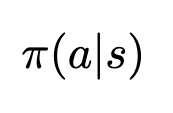
Our policy is currently deterministic, as it selects actions based on the highest expected action-value. In other words, actions that have a low action-value will never be selected, while actions with a high Q-value will always be selected. This results in a Bernoulli distribution across possible actions. This is very rarely beneficial, as we’ll see later.
Applying these expressions to our trajectory, we can define the probability of some trajectory occurring as

For clarity, here’s the original notation for a trajectory:

More concisely, we have

Defining both the trajectory and its probability allows us to substitute these expressions to simplify our definitions for both return and its expected value. The return (sum of rewards), which we’ll define as G based on conventions, can now be written as
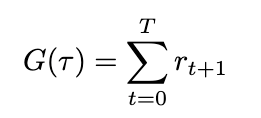
We can also define the expected return by introducing probability into the equation. Since we’ve already defined the probability of a trajectory, the expected return is therefore

We can now adjust the definition of our value functions to include the expected return

The main difference here is the addition of the subscript τ∼π indicating that our trajectory was sampled by following our policy (ie. our actions are selected based on the maximum Q-value). We’ve also removed the subscript t for clarity. Here’s the previous equation again for reference:

So now we have a fairly well-defined expression for estimating return but before we can start iterating through our environment, there’s still some more things to consider. In our frozen lake, it’s fairly unlikely that our agent will continue to explore indefinitely. At some point, it will slip and fall into a hole, and the episode will terminate. However, in practice, RL environments might not have clearly defined endpoints, and training sessions might go on indefinitely. In these situations, given an indefinite amount of time, the expected return would approach infinity, and evaluating the state- and action-value would become impossible. Even in our case, setting a hard limit for computing return is oftentimes not beneficial, and if we set the limit too high, we could end up with pretty absurdly large numbers anyway. In these situations, it is important to ensure that our reward series will converge using a discount factor. This improves stability in the training process and ensures that our return will always be a finite value regardless of how far into the future we look. This type of discounted return is also referred to as infinite horizon discounted return.
To add discounting to our return equation, we’ll introduce a new variable γ (gamma) to represent the discount factor.
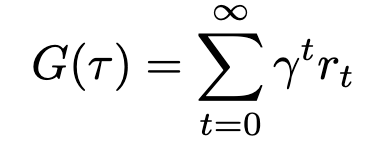
Gamma must always be less than 1, or our series will not converge. Expanding this expression makes this even more apparent

We can see that as time increases, gamma will be raised to a higher and higher power. As gamma is less than 1, raising it to a higher exponent will only make it smaller, thus exponentially decreasing the contribution of future rewards to the overall sum. We can substitute this updated definition of return back into our value functions, though nothing will visibly change since the variable is still the same.

We mentioned earlier that always being greedy is not the best choice. Always selecting our actions based on the maximum Q-value will probably give us the highest chance of maximizing our reward, but that only holds when we have accurate estimates of those Q-values in the first place. To obtain accurate estimates, we need a lot of information, and we can only gain information by trying new things — that is, exploration.
When we select actions based on the highest estimated Q-value, we exploit our current knowledge base: we leverage our accumulated experiences in an attempt to maximize our reward. When we select actions based on any other metric, or even randomly, we explore alternative possibilities in an attempt to gain more useful information to update our Q-value estimates with. In reinforcement learning, we want to balance both exploration and exploitation. To properly exploit our knowledge, we need to have knowledge, and to gain knowledge, we need to explore.
We can balance exploration and exploitation by changing our policy from purely greedy to an epsilon-greedy one. An epsilon-greedy policy acts greedily most of the time with a probability of 1- ε, but has a probability of ε to act randomly. In other words, we’ll exploit our knowledge most of the time in an attempt to maximize reward, and we’ll explore occasionally to gain more knowledge. This is not the only way of balancing exploration and exploitation, but it is one of the simplest and easiest to implement.
Now the we’ve established a basis for understanding RL principles, we can move to discussing the actual algorithm — which will happen in the next article. For now, we’ll go over the high-level overview, combining all these concepts into a cohesive pseudo-code which we can delve into next time.
The focus of this article was to establish the basis for understanding and implementing Q-learning. Q-learning consists of the following steps:
Q-learning is an iterative process where we build estimates of action-value (and expected return), or “experience”, and use our experiences to identify which actions are the most rewarding for us to choose. These experiences are “learned” over many successive iterations of our environment and by leveraging them we will be able to consistently reach our goal, thus solving our MDP.
If you’ve read this far, consider leaving some feedback about the article — I’d appreciate it ❤.
[1] Gymnasium, Frozen Lake (n.d.), OpenAI Gymnasium Documentation.
[2] OpenAI, Spinning Up in Deep RL (n.d.), OpenAI.
[3] R. Sutton and A. Barto, Reinforcement Learning: An Introduction (2020), http://incompleteideas.net/book/RLbook2020.pdf
[4] Spiceworks, What is a Markov Decision Process? (n.d.), Spiceworks
[5] IBM, Reinforcement Learning (n.d.), IBM
An Intuitive Introduction to Reinforcement Learning, Part I was originally published in Towards Data Science on Medium, where people are continuing the conversation by highlighting and responding to this story.
Originally appeared here:
An Intuitive Introduction to Reinforcement Learning, Part I
Go Here to Read this Fast! An Intuitive Introduction to Reinforcement Learning, Part I


The engaging discussions sparked by my recent blog post, “We Need to Raise the Bar for AI Product Managers,” highlighted a shared passion for advancing the field of AI product management. Many current and aspiring PMs have since reached out, asking how they can learn more about AI on their path to becoming an AI product manager.
In my experience, the most effective AI PMs excel in two key areas: identifying opportunities where AI can add value, and working with model developers to deploy the technology effectively. This requires a solid understanding of how different kinds of models are likely to behave when they go live — a reality that often surprises newcomers. The gap between flashy demos or early-stage prototypes and actual product performance can be substantial, whether you’re dealing with customer-facing applications or backend data pipelines that power products.
The best way to develop this intuition is by deploying a range of models into products and making plenty of mistakes along the way. The next best thing is to explore what other teams at your company are doing and learn from their mistakes (and triumphs). Dig up any documentation you can find and, where possible, listen in on product reviews or team updates. Often, people who worked directly on the projects will be happy to chat, answer your questions, and provide more context, especially if your team might be considering anything similar.
But what if you aren’t working at a company doing anything with AI? Or your company is focused on a very narrow set of technologies? Or maybe you’re in the midst of a job search?
In addition to checking out resources to familiarize yourself with terminology and best practices, I recommend developing your own AI projects. I actually recommend side projects even if you can learn a lot from your day job. Every AI use case has its own nuances, and the more examples you can get close to, the faster you’ll develop an intuition about what does and doesn’t work.
For a starter project, I recommend starting with LLMs like Claude or ChatGPT. You should be able to get something substantial up and running in a matter of hours (minutes if you already know how to code and write effective prompts). While not all AI projects at a real company will use LLMs, they are gaining significant traction. More importantly, it’s much easier to create your own working model with only rudimentary data science or coding knowledge. If your coding skills are rusty, using the developer APIs will give you a chance to brush up, and if you get stuck the LLM is a great resource to help with both code generation and troubleshooting. If you’re new to both coding and LLMs, then using the online chat interface is a great way to warm up.
But what’s the difference between using the ChatGPT website or app to make you more productive (with requests like summarizing an article or drafting an email) versus an actual project?
A project should aim to solve a real problem in a repeatable way. It’s these nuances that will help you hone some of the most important skills for AI product management work at a company, especially model evaluation. Check out my article “What Exactly is an Eval and Why Should Product Managers Care” for an overview of model evaluation basics.
To ensure what you’re working on is a real project that can have its own mini eval, make sure you have:
Please don’t do these specific projects unless one of them really speaks to you. These are for illustrative purposes only to help convey what makes a real project, versus a one-off query:

You’re welcome to use any LLM for these projects, but in my experience, the ChatGPT API is the easiest to get started with if you have limited coding experience. Once you’ve successfully completed one project, evaluating another LLM on the same data is relatively straightforward.
Remember, the goal of starter projects isn’t perfection but to find an interesting project with some complexity to ensure you encounter difficulties. Learning to troubleshoot, iterate, and even hit walls where you realize something isn’t possible will help you hone your intuition for what is and isn’t feasible, and how much work is involved.
Developing a strong intuition for AI capabilities and limitations is crucial for effective AI product management. By engaging in hands-on projects, you’ll gain invaluable experience in model evaluation, troubleshooting, and iteration. This practical knowledge will make you a more effective partner to model developers, enabling you to:
As you tackle these projects, you’ll develop a nuanced understanding of AI’s real-world applications and challenges. This experience will set you apart in the rapidly evolving field of AI product management, preparing you to lead innovative projects and make informed decisions that drive product success.
Remember, the journey to becoming an expert AI PM is ongoing. Embrace the learning process, stay curious, and continually seek out new challenges to refine your skills. With dedication and hands-on experience, you’ll be well-equipped to navigate the exciting frontier of AI product development.
Have questions about your AI project or this article? Connect with me on LinkedIn to continue the conversation.
The DIY Path to AI Product Management: Picking a Starter Project was originally published in Towards Data Science on Medium, where people are continuing the conversation by highlighting and responding to this story.
Originally appeared here:
The DIY Path to AI Product Management: Picking a Starter Project
Go Here to Read this Fast! The DIY Path to AI Product Management: Picking a Starter Project
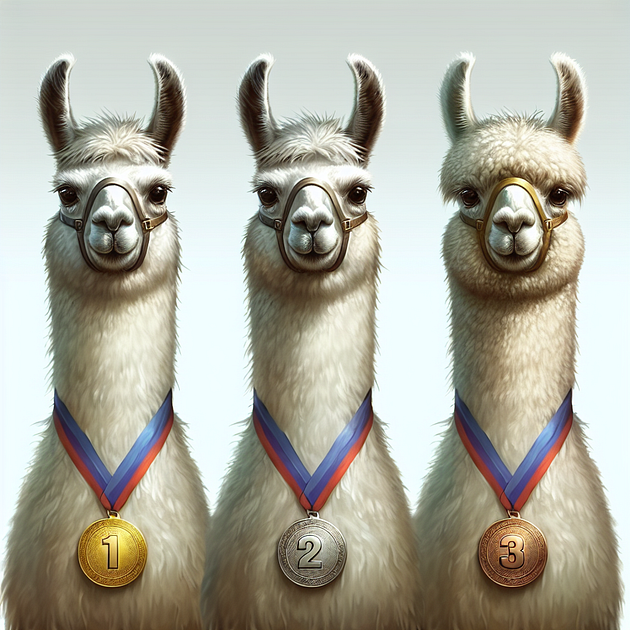
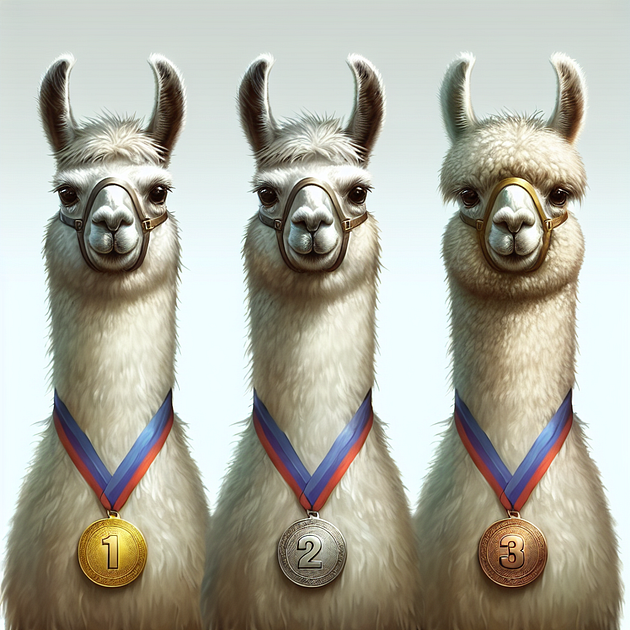
A Comprehensive Guide to the Advancements and Innovations in the Family of Llama Models from Meta AI
Originally appeared here:
The Evolution of Llama: From Llama 1 to Llama 3.1
Go Here to Read this Fast! The Evolution of Llama: From Llama 1 to Llama 3.1
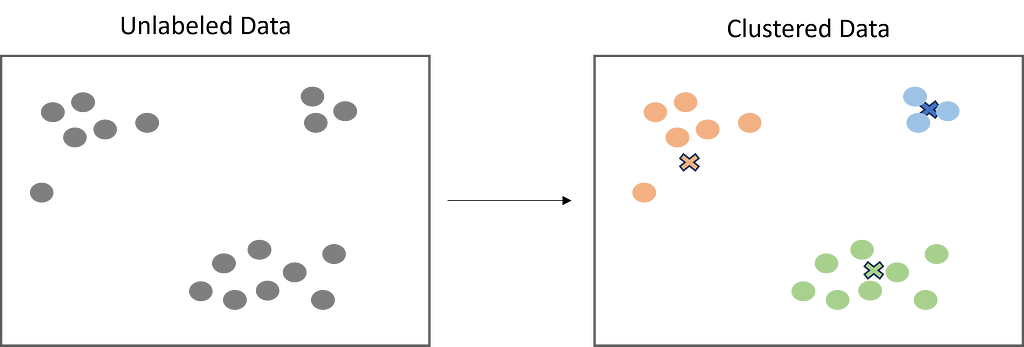
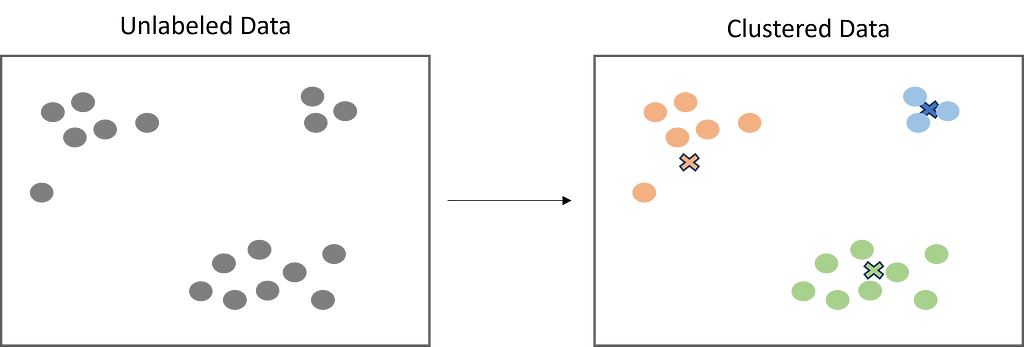
Clustering is a must-have skill set for any data scientist due to its utility and flexibility to real-world problems. This article is an overview of clustering and the different types of clustering algorithms.
Clustering is a popular unsupervised learning technique that is designed to group objects or observations together based on their similarities. Clustering has a lot of useful applications such as market segmentation, recommendation systems, exploratory analysis, and more.

While clustering is a well-known and widely used technique in the field of data science, some may not be aware of the different types of clustering algorithms. While there are just a few, it is important to understand these algorithms and how they work to get the best results for your use case.
Centroid-based clustering is what most think of when it comes to clustering. It is the “traditional” way to cluster data by using a defined number of centroids (centers) to group data points based on their distance to each centroid. The centroid ultimately becomes the mean of it’s assigned data points. While centroid-based clustering is powerful, it is not robust against outliers, as outliers will need to be assigned to a cluster.
K-Means is the most widely used clustering algorithm, and is likely the first one you will learn as a data scientist. As explained above, the objective is to minimize the sum of distances between the data points and the cluster centroid to identify the correct group that each data point should belong to. Here’s how it works:

from sklearn.cluster import KMeans
import numpy as np
#sample data
X = np.array([[1, 2], [1, 4], [1, 0],
[10, 2], [10, 4], [10, 0]])
#create k-means model
kmeans = KMeans(n_clusters = 2, random_state = 0, n_init = "auto").fit(X)
#print the results, use to predict, and print centers
kmeans.labels_
kmeans.predict([[0, 0], [12, 3]])
kmeans.cluster_centers_
K-Means ++ is an improvement of the initialization step of K-Means. Since the centroids are randomly dropped in, there is a chance that more than one centroid might be initialized into the same cluster, resulting in poor results.
However K-Means ++ solves this by randomly assigning the first centroid that will eventually find the largest cluster. Then, the other centroids are placed a certain distance away from the initial cluster. The goal of K-Means ++ is to push the centroids as far as possible from one another. This results in high-quality clusters that are distinct and well-defined.
from sklearn.cluster import KMeans
import numpy as np
#sample data
X = np.array([[1, 2], [1, 4], [1, 0],
[10, 2], [10, 4], [10, 0]])
#create k-means model
kmeans = KMeans(n_clusters = 2, random_state = 0, n_init = "k-means++").fit(X)
#print the results, use to predict, and print centers
kmeans.labels_
kmeans.predict([[0, 0], [12, 3]])
kmeans.cluster_centers_
Density-based algorithms are also a popular form of clustering. However, instead of measuring from randomly placed centroids, they create clusters by identifying high-density areas within the data. Density-based algorithms do not require a defined number of clusters, and therefore are less work to optimize.
While centroid-based algorithms perform better with spherical clusters, density-based algorithms can take arbitrary shapes and are more flexible. They also do not include outliers in their clusters and therefore are robust. However, they can struggle with data of varying densities and high dimensions.

DBSCAN is the most popular density-based algorithm. DBSCAN works as follows:
from sklearn.cluster import DBSCAN
import numpy as np
#sample data
X = np.array([[1, 2], [2, 2], [2, 3],
[8, 7], [8, 8], [25, 80]])
#create model
clustering = DBSCAN(eps=3, min_samples=2).fit(X)
#print results
clustering.labels_
Next, we have hierarchical clustering. This method starts off by computing a distance matrix from the raw data. This distance matrix is best and often visualized by a dendrogram (see below). Data points are linked together one by one by finding the nearest neighbor to eventually form one giant cluster. Therefore, a cut-off point to identify the clusters by stopping all data points from linking together.

By using this method, the data scientist can build a robust model by defining outliers and excluding them in the other clusters. This method works great against hierarchical data, such as taxonomies. The number of clusters depends on the depth parameter and can be anywhere from 1-n.
from scipy.cluster.hierarchy import dendrogram, linkage
from sklearn.cluster import AgglomerativeClustering
from scipy.cluster.hierarchy import fcluster
#create distance matrix
linkage_data = linkage(data, method = 'ward', metric = 'euclidean', optimal_ordering = True)
#view dendrogram
dendrogram(linkage_data)
plt.title('Hierarchical Clustering Dendrogram')
plt.xlabel('Data point')
plt.ylabel('Distance')
plt.show()
#assign depth and clusters
clusters = fcluster(linkage_data, 2.5, criterion = 'inconsistent', depth = 5)
Lastly, distribution-based clustering considers a metric other than distance and density, and that is probability. Distribution-based clustering assumes that the data is made up of probabilistic distributions, such as normal distributions. The algorithm creates ‘bands’ that represent confidence intervals. The further away a data point is from the center of a cluster, the less confident we are that the data point belongs to that cluster.

Distribution-based clustering is very difficult to implement due to the assumptions it makes. It usually is not recommended unless rigorous analysis has been done to confirm its results. For example, using it to identify customer segments in a marketing dataset, and confirming these segments follow a distribution. This can also be a great method for exploratory analysis to see not only what the centers of clusters comprise of, but also the edges and outliers.
Clustering is an unsupervised machine learning technique that has a growing utility in many fields. It can be used to support data analysis, segmentation projects, recommendation systems, and more. Above we have explored how they work, their pros and cons, code samples, and even some use cases. I would consider experience with clustering algorithms a must-have for data scientists due to their utility and flexibility.
I hope you have enjoyed my article! Please feel free to comment, ask questions, or request other topics.
A Guide to Clustering Algorithms was originally published in Towards Data Science on Medium, where people are continuing the conversation by highlighting and responding to this story.
Originally appeared here:
A Guide to Clustering Algorithms